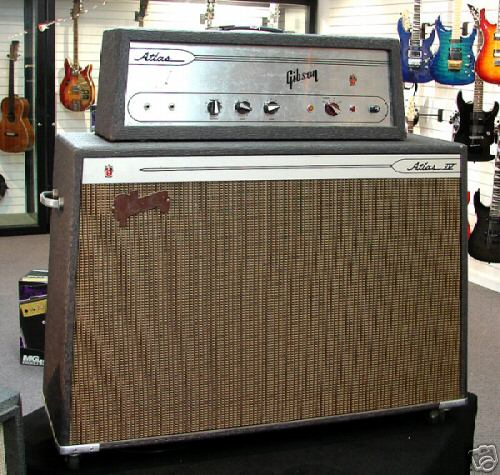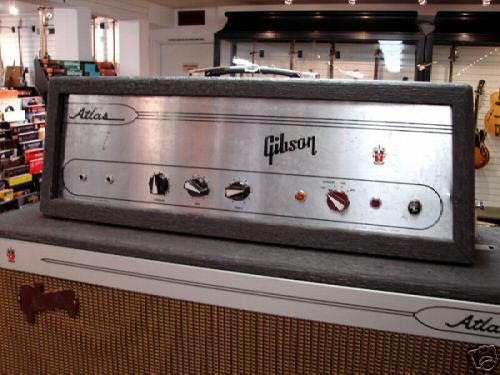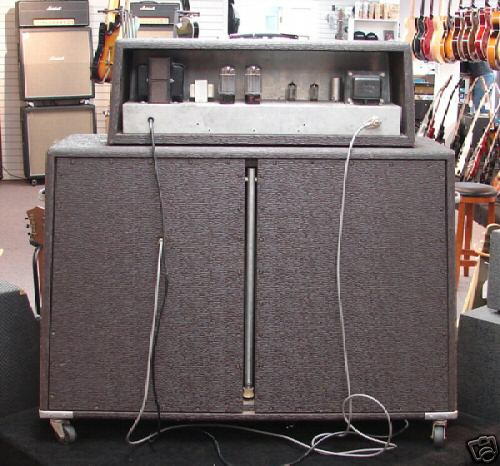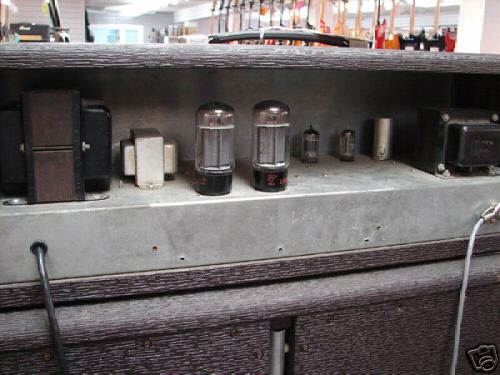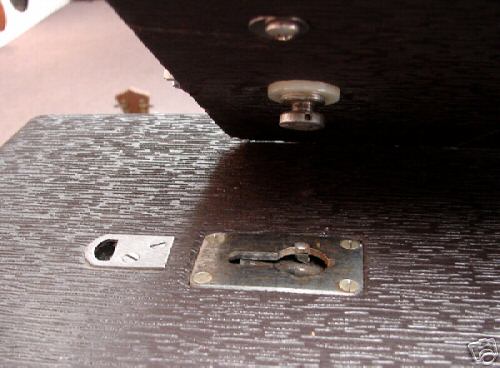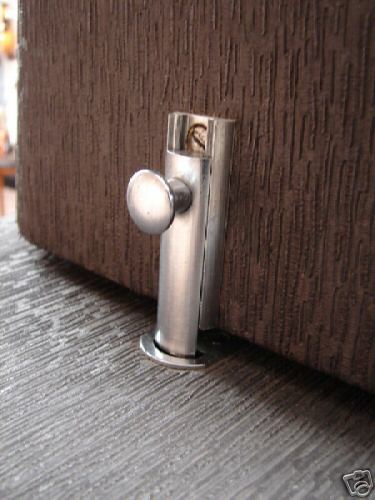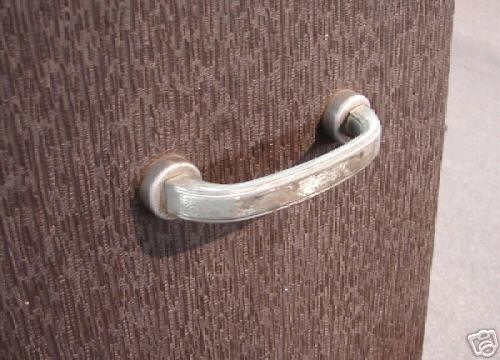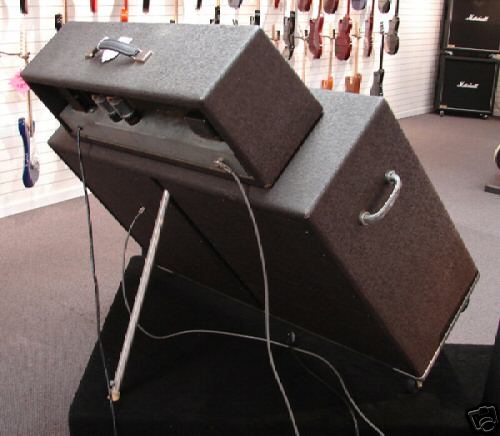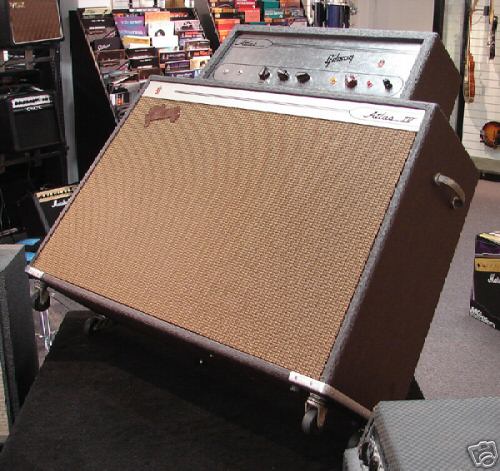 |
Top | Main | Amps | Links | Other Stuff
 |
GA-80 Vari-Tone (tweed)
|
|
25W 2x15" Guitar Combo
Speaker: 2x15"
Inputs: 2+2
Channels: 2
Volume Controls: 2
Tone Controls on Each Channel: 2, 6 pre-sel. switch
Tremolo: No
Tubes: 7
Extension Speaker Jack: No
Monitor Jack: No
Watts Output: 25
Shipping Totals: 1959: 282, 1960: 181, 1961: 131
Harmony Central Review GA80 Vari-Tone
With improved tremolo and 6 preset tone control switches. (www.drtube.com, March 28, 2003)
Push-pull 6L6GBs; no Fender close model; two channels, one with push-button tone settings. Uses 5879s in second preamp stages (Miles O'Neal's web-site; May 30, 2003)
Rate the GA-80 Vari-Tone (tweed)...
|
 |
GA-83S Stereo-Vib (tweed)
|
|
2x18W 4x8" and 1x12" Guitar Combo with Stereo Vibrato
Speakers: 4x8" & 1x12" (Jensens)
Inputs: 2 stereo, 2 mono
Channels: 2
Volume Controls: 2
Tone Controls on Each Channel: Bass, treble
Tremolo: Vibrato depth, frequency
Reverb: No
Tubes: 13 (4x12AX7, 12AU7, 3x6CG7, 4x6BQ5, GZ34)
Diodes:
Extension Speaker Jack: No
Monitor Jack: No
Watts Output: 2x18
Shipping Totals: 1959: 125, 1960: 128, 1961: 26
The Gibson GA-83S was a short lived model introduced around 1959. About the size of a Fender Twin, it has the classic tweed look of late 1950s Gibson amplifiers. The only effect that the amp features is tremolo, but this is to be expected since the design predates the age of combo amps with on-board reverb (1961). The Gibson catalog claims true vibrato (pitch modulation) for this amp, but after listening to the true vibrato Magnatone amps, the Gibson sounds like it has tremolo (volume modulation) very similar to that used on brown Tolex Fenders (i.e. terrific).
It has a single Jensen P12R mounted to the front baffleboard and a pair of Jensen P8Ts mounted to each side baffle. Yes, that's right... this amp has a pair of 8 inch speakers mounted on each side of the amp! The side mounted speakers are not just there for CGF (Cool Guy Factor). They play an important role in the unique sound of this amp which we'll get to in a moment.
First, let's go over the tube compliment. Every true stereo amp has two separate power amps. As such, they have more tubes, an additional output transformer, and sometimes an extra power supply compared to a standard mono amp. The GA-83S uses a single power supply rectified by a 5AR4, a pair of cathode biased 6BQ5/EL-84 power tubes for each amp, and preamp sections fueled by four 12AX7s, three 6CG7s, and a single 12AU7. These tubes are readily available and not too expensive. The amp is good for about 17 watts per side (stereo) or 35 watts mono.
The controls are smartly laid out. There are two stereo input jacks and two mono inputs jacks. There are three stacked pots each with concentric knobs for volume, treble and bass. The outer knob controls one channel while the inner knob controls the other. This makes it quick and easy to find the correct knob for adjusting. A tremolo frequency control and a tremolo depth control are also present, as well as a stereo/mono selector switch. A footswitch jack for activating the tremolo effect is located under the chassis. Sadly, this amp was missing its footswitch so a grounding plug had to be fabricated in order to activate the tremolo.
In mono mode, the amp is plenty loud and sounds fabulous for blues and rock. The 6BQ5s go into a creamy smooth overdrive about a quarter of the way up the volume dial. Clean tone is limited, but boy what a great sound it has. In stereo mode, the amp suddenly becomes "three dimensional" sounding. It's no different than if you are listening to an FM station that is not precisely tuned in (mono signal) and then suddenly you get it tuned in perfectly and the stereo signal makes the sound "jump out" at you. Believe me, it's difficult to play a mono amp after playing a great sounding stereo amp.
The side mounted speakers add to the "presence" factor of the amp. They also have a magic effect on the tremolo signal. In mono mode, the tremolo is typical of that found on any late 1950s guitar amp, which is to say, quite nice. However, in stereo mode the tremolo pans between the left and right set of speakers. The resulting sound is unbelievably cool since it sounds like a Leslie rotating speaker!! Wow! You don't miss having reverb with this amp at all. The bluesy overdrive and the pseudo-Leslie effect are all that you could want or need. [...]
The Gibson GA-83S is just too cool to look at, too cool for blues tone, and too cool with its Leslie effect that I've got to have one someday. However, despite it's high CGF (how many amps do you know with five speakers?), it really is tonally limited to one, albeit great, sound. Better yet is the Gibson GA-79RVT because it has reverb and a little more headroom to add to its versatility. (Copyright 1997, 20th Century Guitar Magazine; pirated without permission from Greg Gagliano's web-site at http://home.att.net/~gggjaguar)
GA-83S Stereo-Vib, stereo, push-pull 6BQ5s each side (Miles O'Neal's web-site; May 30, 2003)
1958 Gibson GA-83S, Tweed, 9+, $2495 (see pics)
This is the coolest and rarest of the gibson Tweed era amps. It has one 12 inch Jensen and four 8 inch jensens, all original. In stereo the tremelo goes left to right like a leslie. This one actually still has the Stack knobs intact. (Fralin Pickups on Gbase Gear Mall)
I can't remember exactly what year I bought my Gibson GA-83S but I do know I was in high school and it was in the early '60's'. I can't remember it's exact cost either but I paid $310.00 for it and a Gretsch Anniversary model guitar. I have played this amp for almost 50 years and have only changed the tubes 3 times! It sounded good back then and it still sounds good now! I lost 1/2 of one of the knobs sometime,somewhere but that's all that's wrong with the amp. I played it a dances in high school, aboard ship when I was in the Navy, a few country bands in the mid 70's, and of course in my living room! It's a great amp and brings a lot of fine memories for me! (Tom Kuzia)
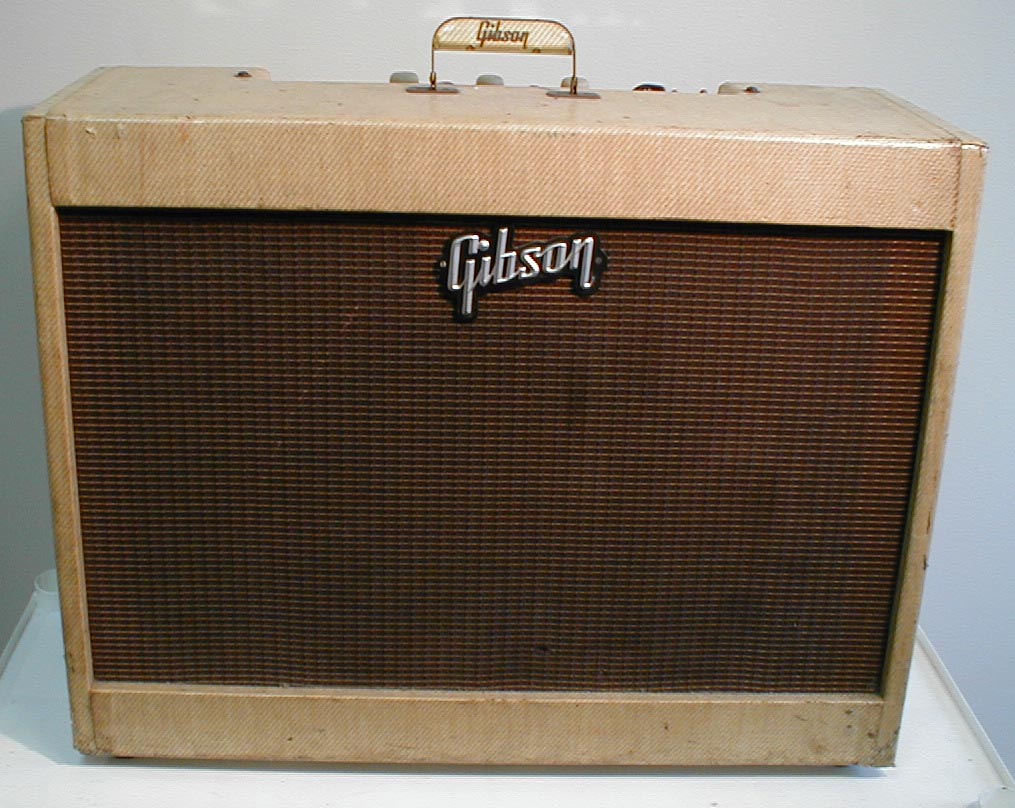 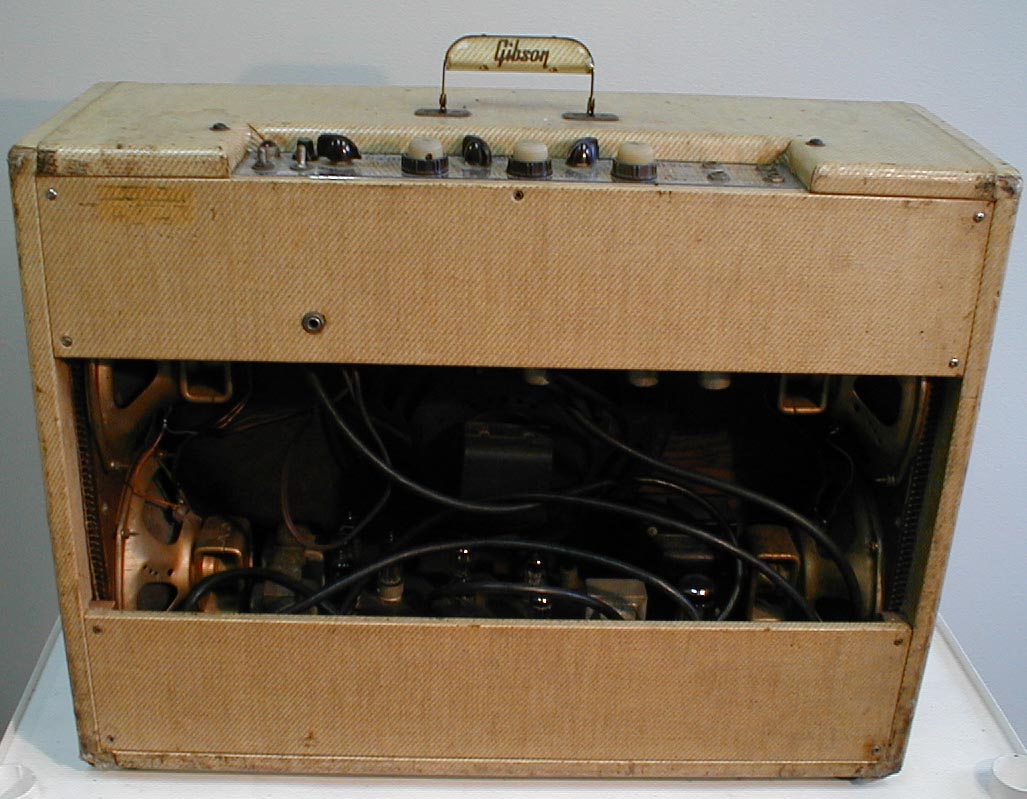
Rate the GA-83S Stereo-Vib (tweed)...
|
 |
GA-85 (two-tone)
|
|
25W 1x12" Guitar Combo
Speakers: 1x12"
Inputs: 2+2
Channels: 2
Volume Controls: 2
Tone Controls on Each Channel: Bass, treble, Voicing
Tremolo: No
Tubes: 6 (2x12AX7, 2x5881, 5V6, 5V4)
Extension Speaker Jack: Yes
Monitor Jack: Yes
Watts Output: 25
Shipping Totals: 1957: 4, 1958: 56
Rate the GA-85 (two-tone)...
|
 |
GA-86 Ensamble (tweed)
|
|
25W 1x12" Guitar Head with Cabinet
Speaker: 12"
Inputs: 2+2
Channels: 2
Volume Controls: 2
Tone Controls on Each Channel: Bass, treble
Tremolo: No
Tubes: 7 (2x12AX7, 2x5881, 6V6, GZ34)
Extension Speaker Jack: Yes
Monitor Jack: Yes
Watts Output: 25
Shipping Totals: 1959: 13, 1960: 22, 1961: 7
With removable control panel. (www.drtube.com, March 28, 2003)
Push-pull 6BQ5s; no close Fender model; single channel version of GA-79RVT, but with a 6V6 driving the middle leg of the output transformer [or not? see the German text below]! Tres bizarre. (Miles O'Neal's web-site; May 30, 2003)
Die 6V6 treibt beim GA86 nicht die Mittelanzapfung, wie im kleinen Kommentar steht. Sie holt sich von dem die Versorgungsspannung und ist als Längsregler zur Stabilisierung eingesetzt. Damit haben die Schirmgitter und letztlich auch die Vorstufen eine stabile und damit sehr brummfreie Spannungsversorgung. (Martin)
Pretty unique [amp], losts of clean headroom, good tone, great for blues with an overdrive. You can jumper the second channel to the first for an increase in gain and more clipping.
This 59 [see pics] is in great shape with the original jensen p12p looks new, the inside the chassis is clean as a whistle, only thing not original are the Canadian Made tubes.
Tube line up is , 12ax7 x 2, 6L6gc x 2 (big bottle), the weird 5V6(6V6) in most schematics, looking at the drawing you can see the tube is attached to the 5 volt tap and the GZ 34 rectifer. (Bill)
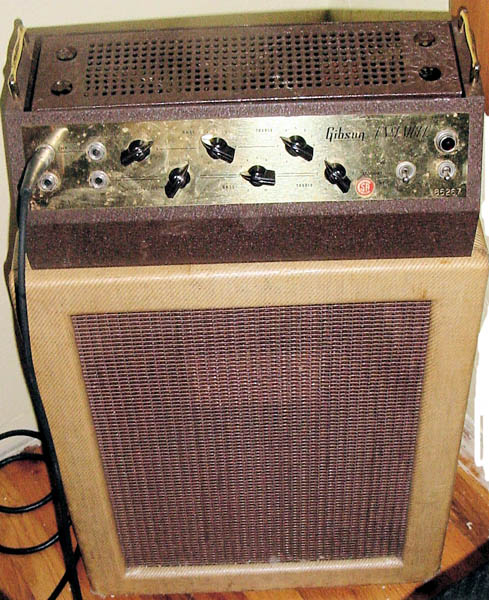 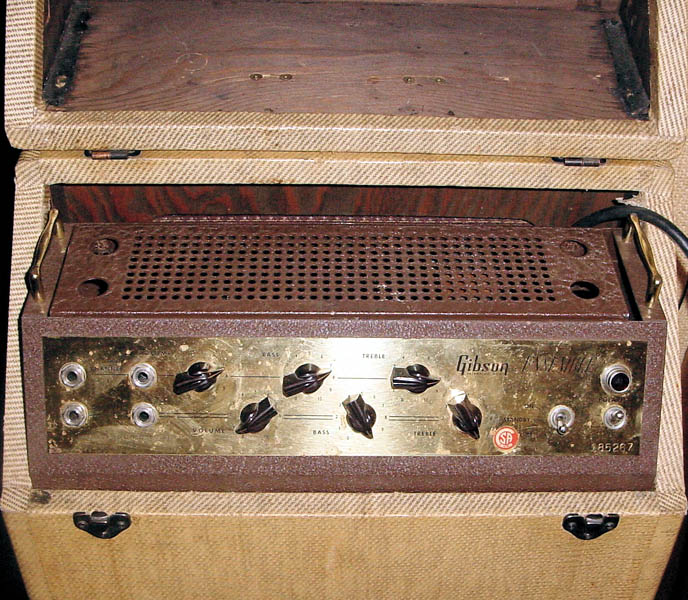
Rate the GA-86 Ensamble (tweed)...
|
 |
GA-87 Stereo Maestro (tweed)
|
|
2x18W 2x12" Accordion Combo with Reverb
Speakers: 2x12"
Inputs: 2 stereo, 2 mono
Channels: 2
Volume Controls: 2
Tone Controls on Each Channel: Bass, treble
Tremolo: No
Reverb: No
Tubes: 8 (3x12AX7, 4x6BQ5, GZ34)
Diodes:
Extension Speaker Jack: No
Monitor Jack: No
Watts Output: 2x18
Shipping Totals: 1960: 10, 1961: 3
Rate the GA-87 Stereo Maestro (tweed)...
|
 |
GA-88S Stereo Twin (tweed)
|
|
2x18W 2x12" Guitar Combo
Speakers: 2x12"
Inputs: 2 stereo, 2 mono
Channels: 2
Volume Controls: 2
Tone Controls on Each Channel: Bass, treble
Tremolo: No
Reverb: No
Tubes: 8 (3x12AX7, 4x6BQ5, GZ34)
Diodes: No
Extension Speaker Jack: No
Monitor Jack: No
Watts Output: 2x18
Shipping Totals: 1959: 97, 1960: 102, 1961: 37
Stereo, push-pull 6BQ5s each side; no close Fender model; similar to GA-79RVT, but no reverb or tremolo, with separate head and two speaker cabs (Miles O'Neal's web-site; May 30, 2003)
Rate the GA-88S Stereo Twin (tweed)...
|
 |
GA-90
|
|
25W 6x8" Guitar Combo
Speakers: 6x8"
Inputs (instr. + mic.): 2+2* (*hi-gain switch)
Channels: 2
Volume Controls: 2
Tone Controls: 1 (early); later Bass, treble for each channel
Tubes: 8
Preamp Tubes: 2x5879, 12AU7
Phase splitter Tubes: 2x6SN7
Output Tubes: 2x6L6 (5881)
Rectifier Tubes: 5V4
Watts Output: 25
Shipping Totals: 1953: 65, 1954: 333, 1955: 163, 1956: 164, 1957: 124, 1958: 50, 1959: 45, 1960: 3
Harmony Central Review GA90 Combo
This amp was introduced in 1953. (www.drtube.com, March 28, 2003)
[This amp] sounds so great for guitar I could not bring myself to change it (see pics). The stock tube line-up is 2x5879, 1x12AU7 2x6L6 and 1x5V4. This tube combination yields a great jazz amp with the six 8 inch speaker giving great clarity and definition to the mids and also a good tight and ample bottom end. You can also turn it into a raging blues and rock monster by just changing the 12AU7 to a 12AX7. It has one high gain channel and a normal so by using an AB box it is like having and extra lead channel. It sounds like no other amp I have ever heard maybe like a pentode driven tweed deluxe on steroids with a great tight mid-bass thump and fantastic mids with warmth. (ebay, June 21, 2003)
The amp on the pics below is probably a 1956 (dating on speakers). Bought it specially for harmonica but I havent heard it sofar because of a litle malfunction in the amp (something with the power supp) (Jack).
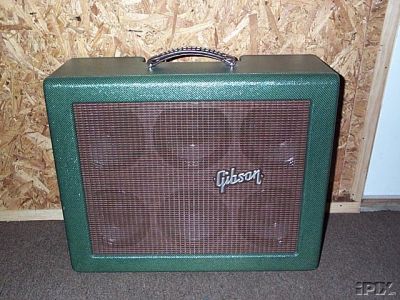 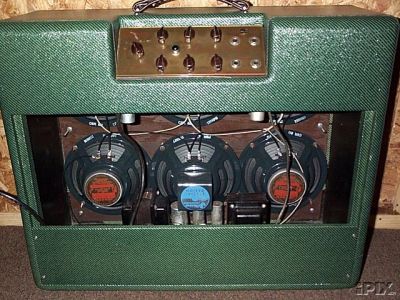 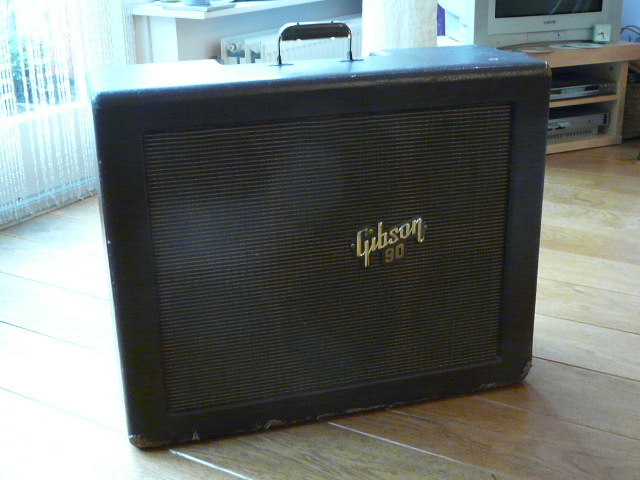 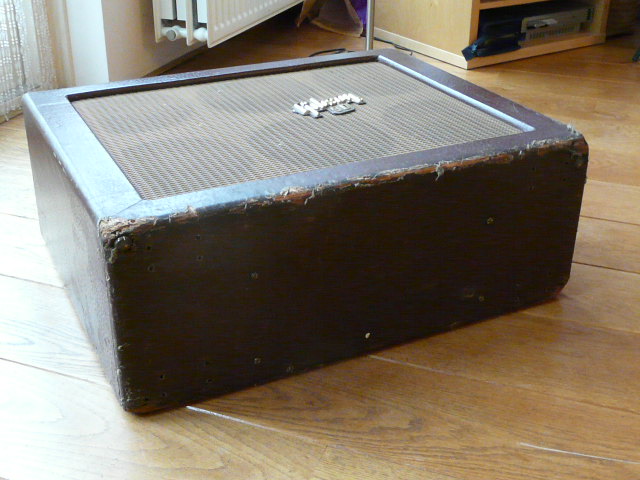  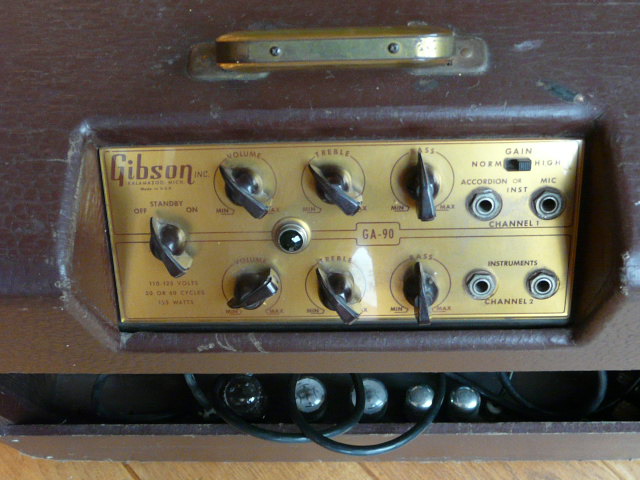 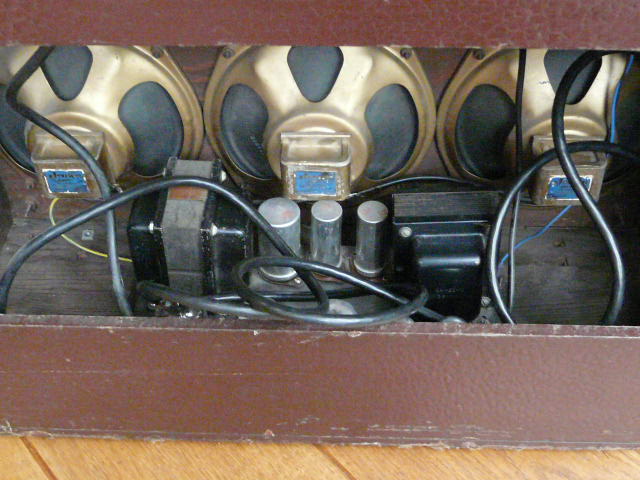 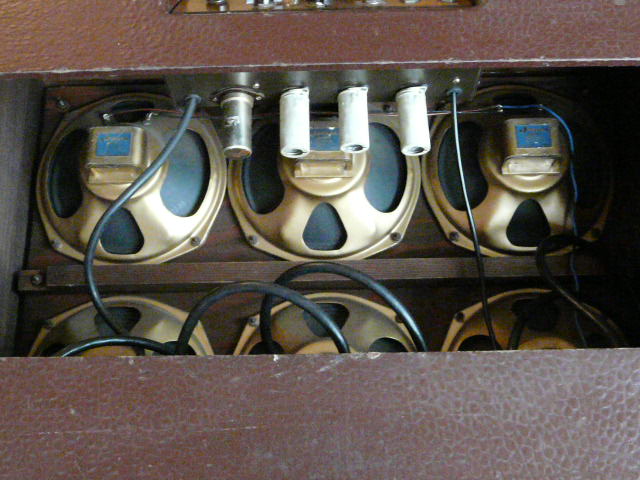 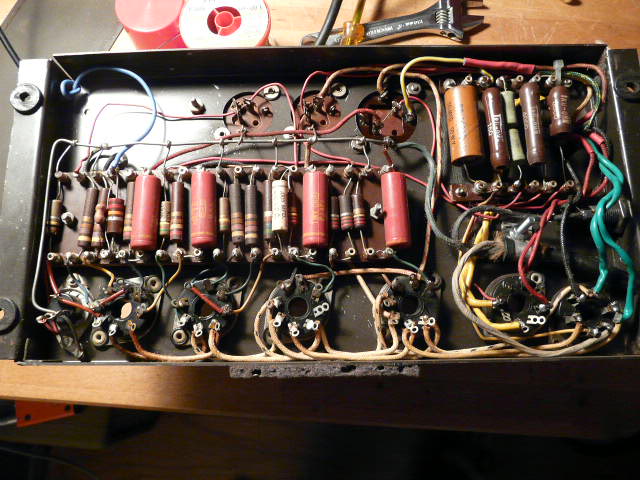 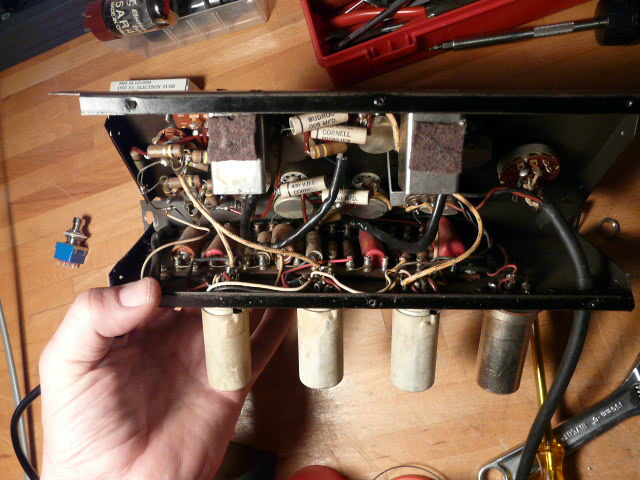 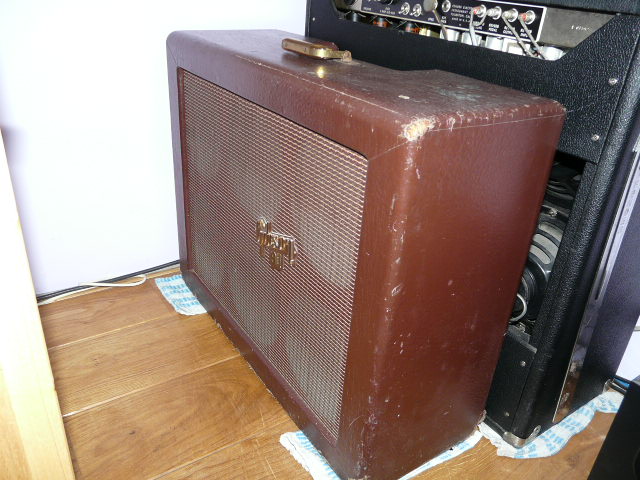 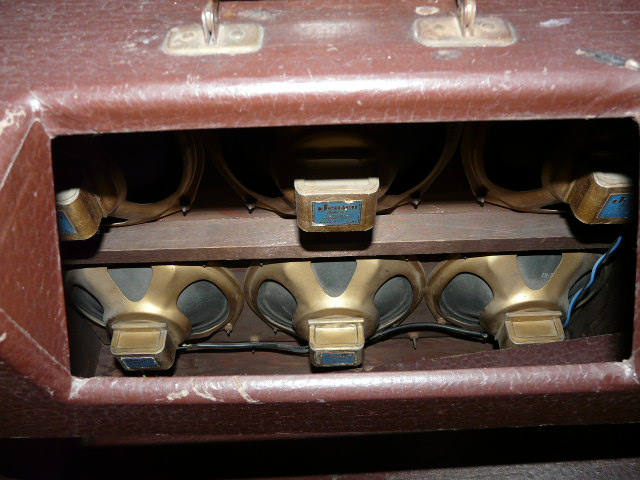 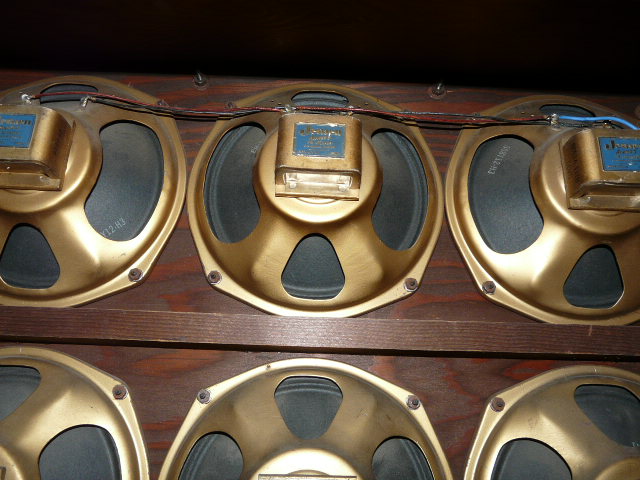
Rate the GA-90...
|
 |
GA-95RVT Apollo (White Panel)
|
|
2x12" Guitar Combo
Speakers: 2x12" (cheap Utahs or Eminence?)
Inputs: 2+2
Channels: 2
Volume Controls: 2
Tone Controls on Each Channel: Bass, middle, treble
Jazz Switch: Yes
Presence Switch: 2
Tremolo: Yes
Reverb: Yes
Tubes: 10 (2x6EU7, 2x12AU7, 12AX7, 4x6L6, 0A2 (correspond to Epiphone EA-300RVT Embassy))
Diodes: 3
Extension Speaker Jack: Yes
Monitor Jack: No
Watts Output:
Shipping Totals: 1965: 98, 1966: 403, 1967: 247
I used to own one [a Gibson GA-95RVT amp]. It was a decent Knock-Off of the Twin-Reverb.
The only problem was that it did not break-up until it reached an
ear-splitting volume. Amp was designed with a 0A2 voltage regulator
tube that designer Seth Lover insisted would help to reduce distortion.
This worked very well, too well for me in the '70's
Change all channel coupling caps, pwr. supply caps. The Russians
will sell you the tubes. Have a tech bias them so you'll be off
to a good start.An amp made like that could sell for $1500+ today.
I think the original speakers were cheap Utah's or Eminance.
Probably whatever hit the loading dock in Kalamazoo. You'll have
to choose a speaker that has similar character or suffer a upper
midrange shift.
Because it's not cool or collectable, you can own it for a song.
Have fun with it! (Mike Miller (mjmiller@uci.edu), 'Re: Opinions Please - Gibson GA95 RVT Amp', rec.audio.tubes,rec.music.makers.guitar, Aug 26, 1996)
_front_2000x1500.jpg) _back_2000x1500.jpg)
Rate the GA-95RVT Apollo (White Panel)...
|
 |
GA-95RVTL Apollo (White Panel)
|
|
2x12" Guitar Combo
Speakers: JBL?
Inputs: 2+2?
Channels: 2?
Volume Controls: 2?
Tone Controls on Each Channel: Bass, middle, treble?
Jazz Switch: Yes?
Presence Switch: 2?
Tremolo: Yes
Reverb: Yes
Tubes: 10 (2x6EU7, 2x12AU7, 12AX7, 4x6L6, 0A2 (correspond to Epiphone EA-300RVT Embassy))?
Diodes: 3?
Extension Speaker Jack: Yes?
Monitor Jack: No?
Watts Output:
Shipping Totals: 1966: 4, 1967: 20
Rate the GA-95RVTL Apollo (White Panel)...
|
 |
GA-100 Bass (tweed)
|
|
35W 1x12" Bass Combo
Speaker: 1x12"
Inputs: 2
Channels: 1
Volume Controls: 1
Tone Controls on Each Channel: Bass, treble
Tremolo: No
Tubes: 9 (6EU7, 2x6BD6, 2x6FM8, 2x6L6, GZ34, 0A2 (correspond to Epiphone EA-70 Bass-Amp))
Extension Speaker Jack: Yes
Monitor Jack: No
Watts Output: 35
Shipping Totals: 1960: 113, 1961: 246
I recently procured a 1960 GA-100 Bass Amp. The cab had serious water damage so I had it professionally recovered by Larry Rogers in Florida. It looks perfect....he emulated the exact Gibson lacquer, etc. Second, one of the magnet poles in the Norelco 12" Alnico speaker was broken. I was going to send it to Ted Weber, but upon putting in a Jensen P12N, I can't imagine it sounding better!
The amp delivers an incredible low frequency presence, just a booming "woomf". I prefer the compressor off. It breaks up warmly at around 6, and can be used in just about any band situation with an [overdrive] pedal. This is an extremely underrated amp, as are most Gibsons, and is a rare gem. (Frank Calarco)
I had one these for about a year. Picked it up for $300 [2005] in very good condition. This amp is a monster, both tonally and weight wise. Built in tube compression with on/off ability. Sounds like a Fender narrow panel tweed Pro. After finding out how many were actually built, I'm sorry I sold it. They turn up on Ebay from time to time. (Scott)
I bought a Gibson GA-100 Bass amp lately [2006]. I am a harmonica player, so I was
curious about how the amp could deal with harp and what sound it would produce...
I can tell you that I am truly satisfied with the sound! Killer tone perfect for harp,
and a very cool and rare amp.
It doesn't have the original speaker so I'm planning to put in a Jensen or a Weber
instead. I was searching an old Premier amp initially but I don't need to search any more. My searching is over. (Erik Dahlberg)
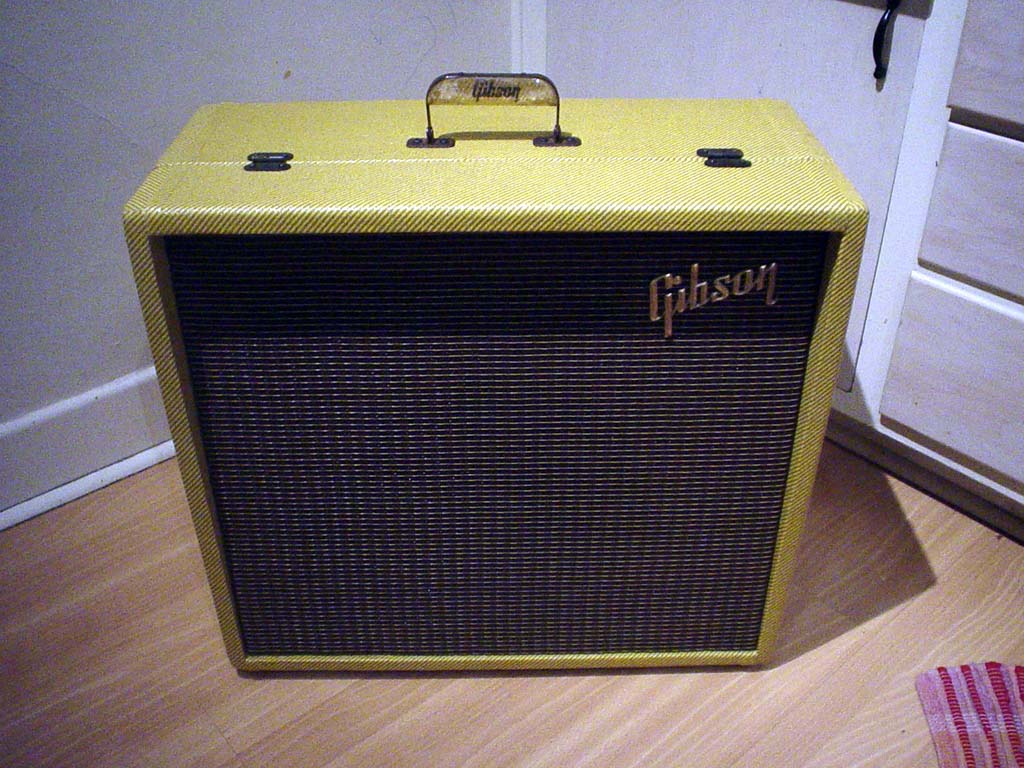 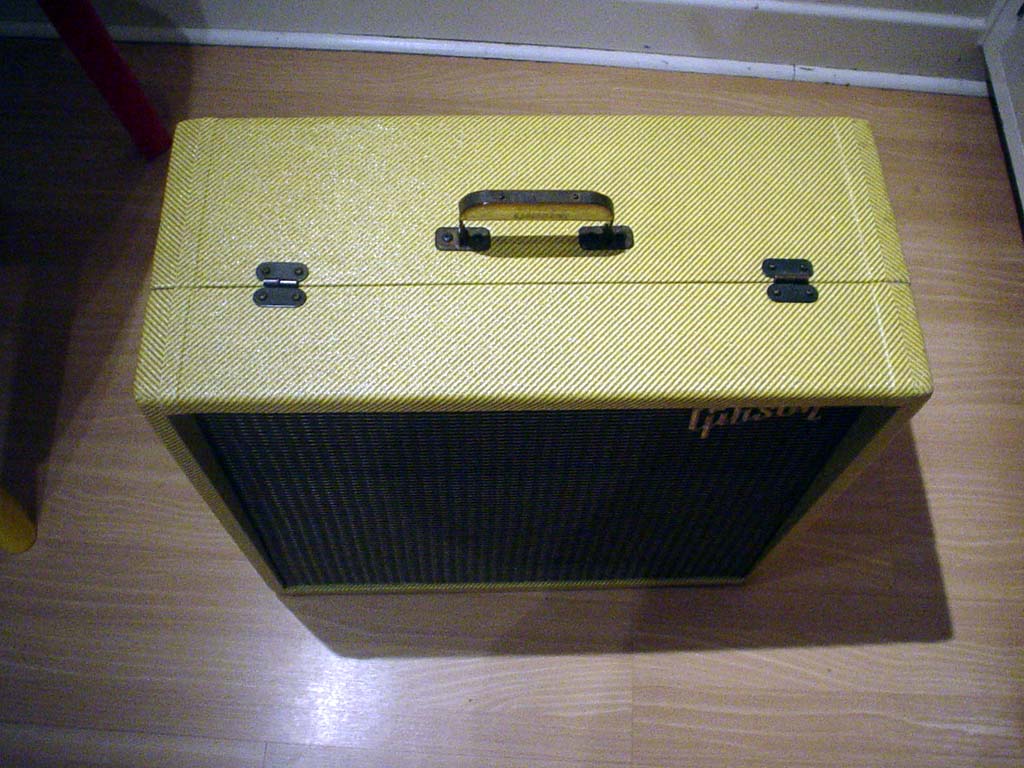 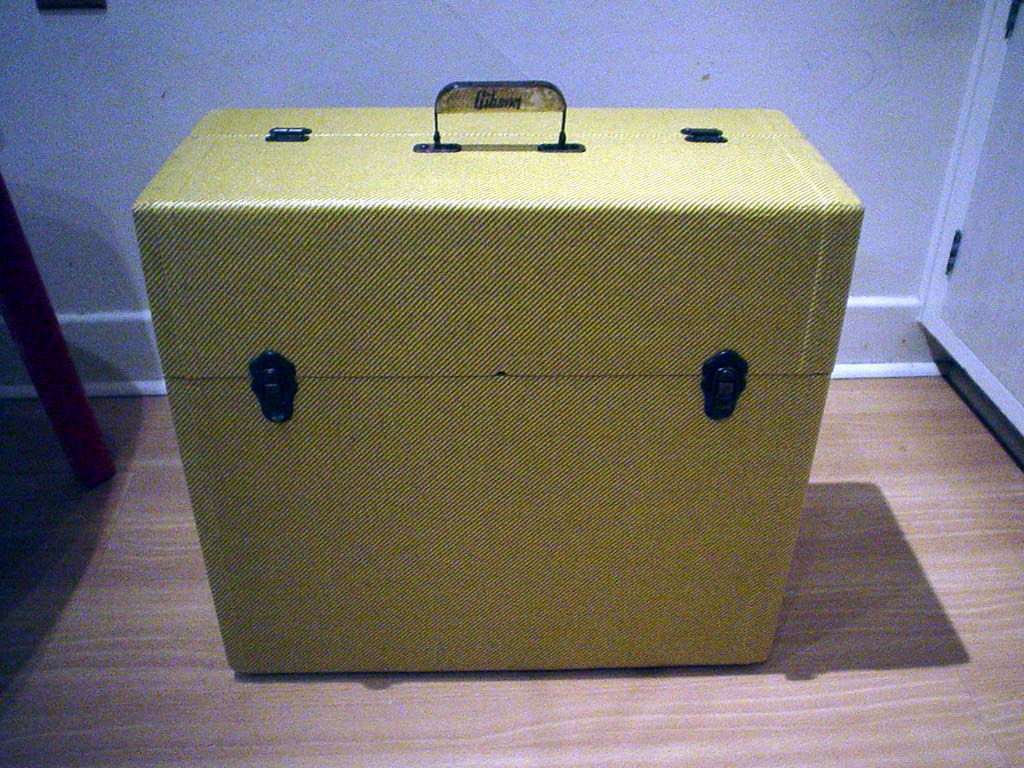 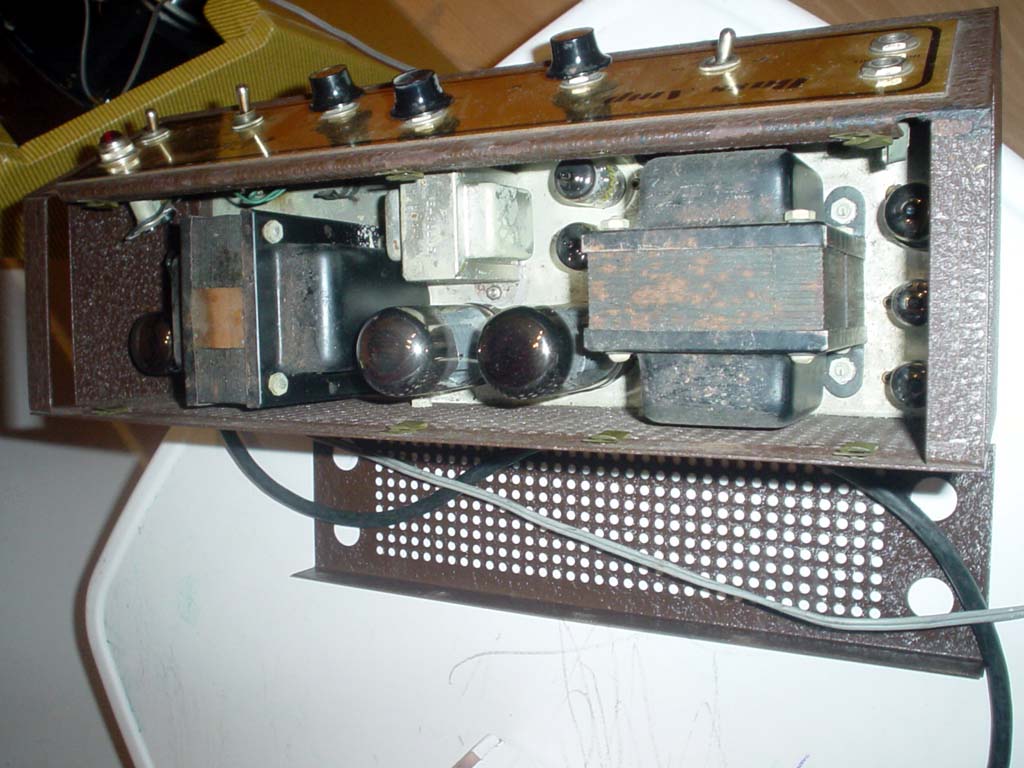  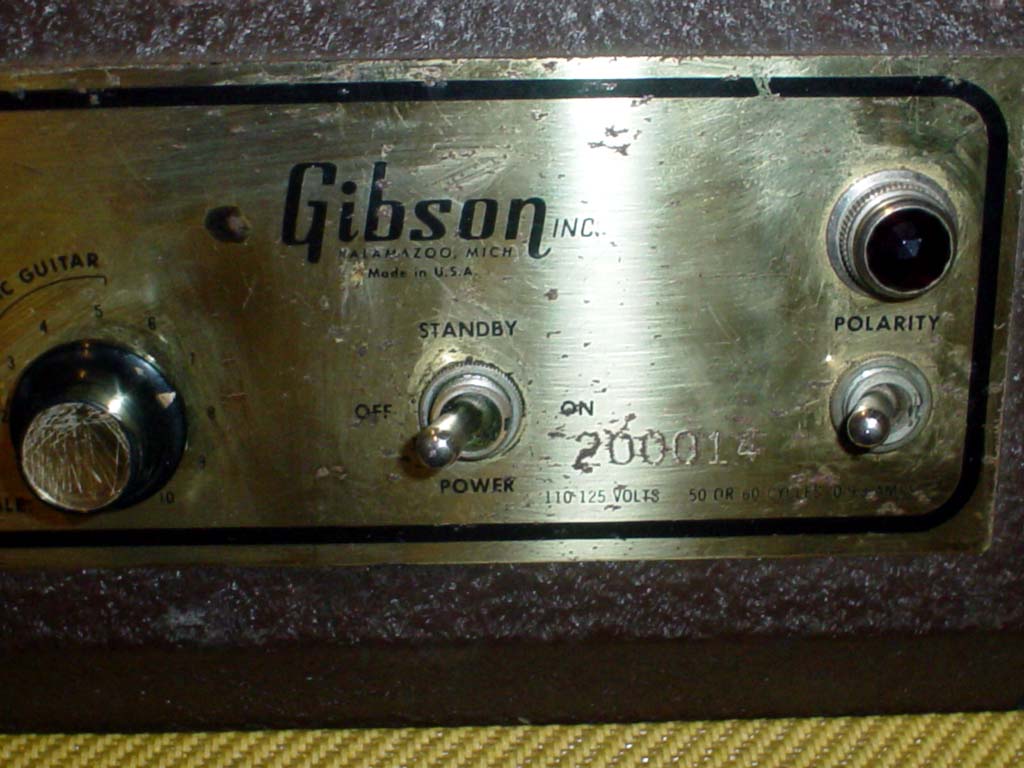 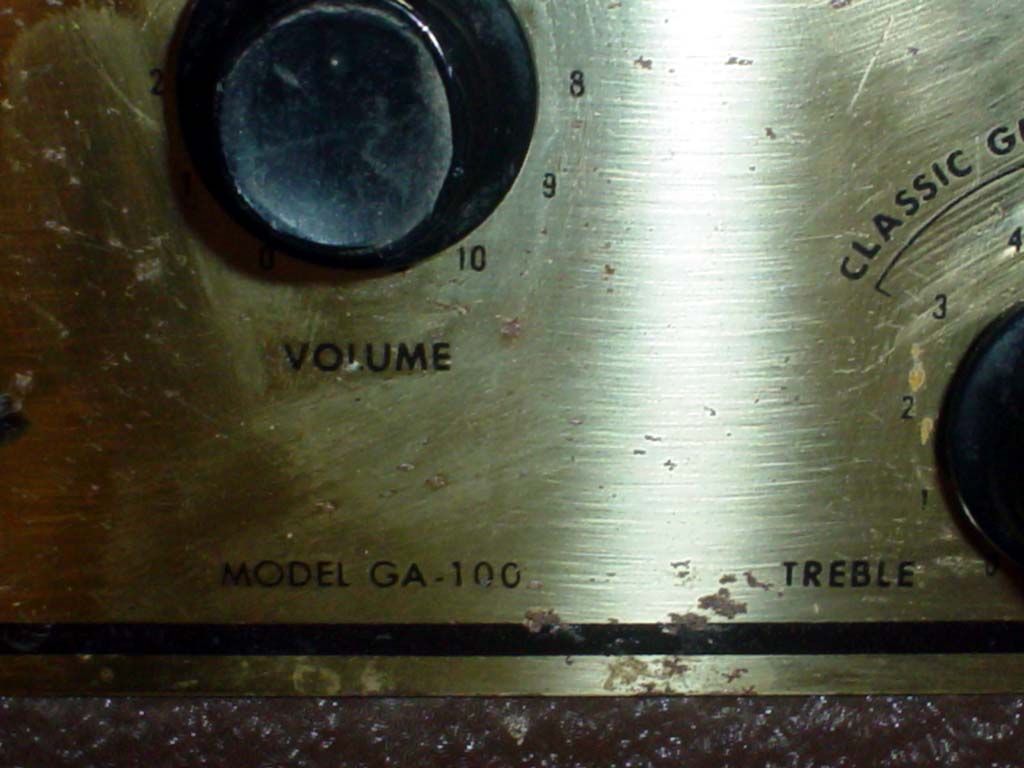 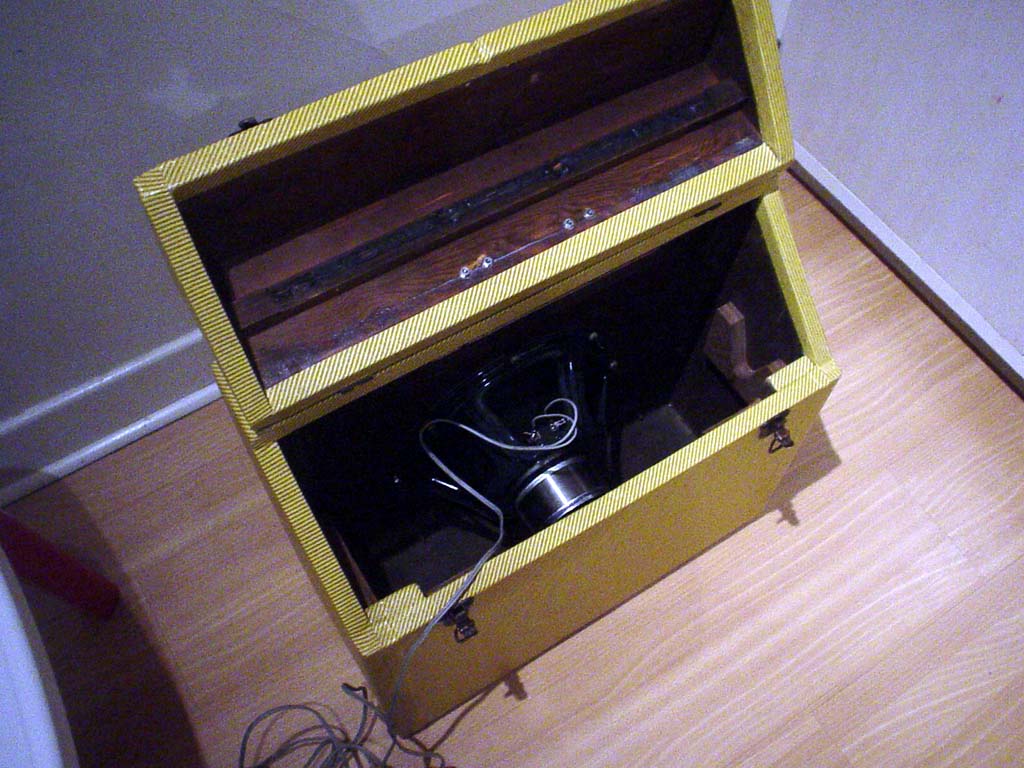 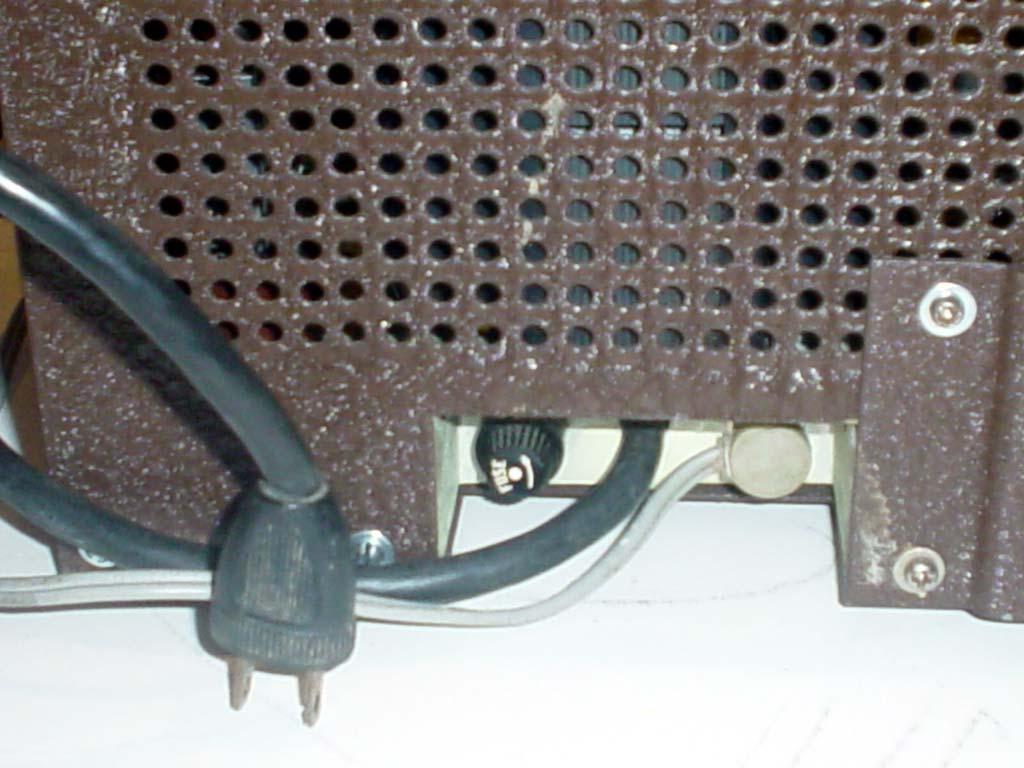  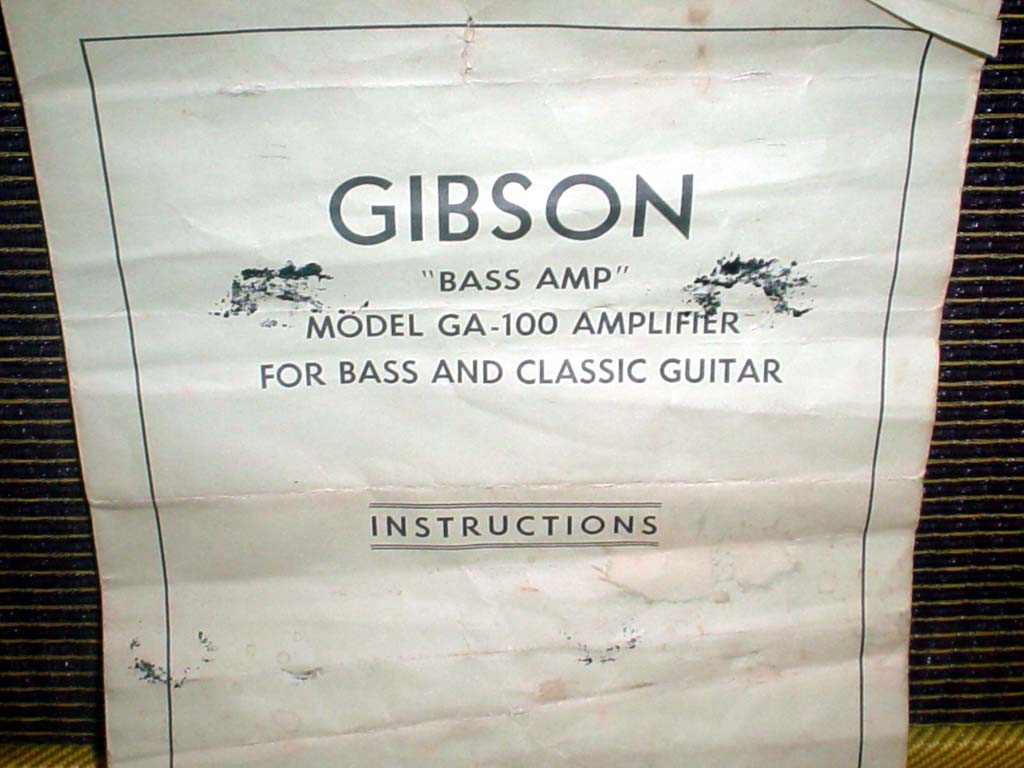
Rate the GA-100 Bass (tweed)...
|
 |
GA-100 Bass (Crestline)
|
|
35W 1x15" Bass Head with Cabinet
Speakers: 1x15"
Inputs: 2
Channels: 1
Volume Controls: 1
Tone Controls on Each Channel: Bass, treble
Tremolo: No
Reverb: No
Compression: No
Tubes: 6
Diodes: 3
Extension Speaker Jack: No
Monitor Jack: No
Watts Output: 35
Shipping Totals: 1962: 227, 1963: 251
The control panel is seperated from the speaker cabinet. This is the same amp as the Epiphone EA-70 Bass amp. (www.drtube.com, March 28, 2003)
Push-pull 6L6GCs; no close Fender model; funky design using cathodyne inverter to drive pentodes which drive the 6L6GCs (Miles O'Neal's web-site; May 30, 2003)
Rate the GA-100 Bass (Crestline)...
|
 |
GA-200 (two-tone), Rhythm King (tweed)
|
|
60W 2x15" Bass Combo
Speakers: 2x12" twin cone
Inputs: 2+2
Channels: 2
Volume Controls: 2
Tone Controls on Each Channel: Bass, treble
Tremolo: No
Tubes: 11 (later 10) (2x12AX7, 12AY7, 2x6BJ8, 2x6SK7, 6V6, 2x6550, GZ34)
Extension Speaker Jack: Yes
Monitor Jack: No
Watts Output: 60
Shipping Totals: 1957: 22, 1958: 71, 1959: 178, 1960: 265, 1961: 263
Harmony Central Review GA200 Rhythm King
Rate the GA-200 (two-tone), Rhythm King (tweed)...
|
 |
GA-200 Rhythm King (Crestline)
|
|
60W 2x12" Bass? Combo
Speakers: 2x12"
Inputs: 2+2
Channels: 2
Volume Controls: 2
Tone Controls on Each Channel: Bass, treble
Tremolo: No
Reverb: No
Compression: No
Tubes: 6
Diodes: 8
Extension Speaker Jack: No
Monitor Jack: Yes
Watts Output: 60
Shipping Totals: 1962: 267, 1963: 302
Two channel high fidelity sound with built in compression circuit to prevent overloading. (www.drtube.com, March 28, 2003)
HEAVY! [...] it weighed about 90lbs to ship. (Tom Wells)
Rate the GA-200 Rhythm King (Crestline)...
|
 |
GA-300RVT Super 300 (Crestline)
|
|
60W 2x12" Guitar Combo with Reverb and Tremolo
Speakers: 2x12"
Inputs: 2+2
Channels: 2
Volume Controls: 2
Tone Controls on Each Channel: Bass, treble
Tremolo: Depth, frequency
Reverb: Yes
Compression: Yes
Tubes: 8 (2x6EU7, 3x12AU7, 7199, 2x6L6, 0A2)
Diodes: 6
Extension Speaker Jack: No
Monitor Jack: Yes
Watts Output: 60
Shipping Totals: 1962: 220, 1963: 321
This is a monster amp, plus it's got the very unique "tuck-away" head feature where the head is stored in the top of the cabinet. This thing really puts out but I may need to play with the tubes because it is sooo clean [...]. (John Nesbitt)
Rate the GA-300RVT Super 300 (Crestline)...
|
 |
GA-400 Super 400 (two-tone)
|
|
60W 2x12" Guitar Combo
Speakers: 2x12" twin cone
Inputs: 2+2+2
Channels: 3
Volume Controls: 3
Tone Controls on Each Channel: Bass, treble
Tremolo: No
Tubes: 12 (later 11) (3x12AX7, 12AY7, 2x6BJ8, 2x6SK7, 6V6, 2x6550, GZ34)
Extension Speaker Jack: Yes
Monitor Jack: No
Watts Output: 60
Shipping Totals: 1957: 15, 1958: 96, 1959: 93, 1960: 112, 1961: 80
Rate the GA-400 Super 400 (two-tone)...
|
 |
GA-400 Super 400 (Crestline)
|
|
60W 2x12" Guitar Combo
Speakers: 2x12"
Inputs: 2+2+2
Channels: 3
Volume Controls: 3
Tone Controls on Each Channel: Bass, treble
Tremolo: No
Reverb: No
Compression: No
Tubes: 6 (3x12AX7, 12AY7, 2x6BJ8)
Diodes: 8
Extension Speaker Jack: No
Monitor Jack: Yes
Watts Output: 60
Shipping Totals: 1962: 89, 1963: 52
Schematic with 3x12AX7, 12AY7, 2x6BJ8
Three channel high fidelity sound with built in compression circuit to prevent overloading. (www.drtube.com, March 28, 2003)
Rate the GA-400 Super 400 (Crestline)...
|
 |
GA-CB
|
|
30-40W 1x15" Guitar Combo
Speakers: 1x15" coaxial woofer-tweeter w/ dividing network 4 sel. switch
Inputs (instr. + mic.): 3+1
Channels: 2
Volume Controls: 2
Tone Controls: Bass, treble
Tremolo: Intensity, frequency
Preamp Tubes: 3x6SJ7, 2x6SQ7
Phase splitter Tubes: 2x6J5
Output Tubes: 2x6L6
Rectifier Tubes: 5T4
Watts Output: 30-40
Shipping Totals: 1949: 35, 1950: 26, 1951: 24, 1952: 22, 1953: 1
Rate the GA-CB...
|
 |
GA-Custom
|
|
Guitar Amp
Speakers:
Inputs (instr. + mic.):
Channels:
Volume Controls:
Tone Controls:
Tremolo:
Tubes: Pre (3x6SJ7, 2x6SQ7, 2x05), Pow (1x6L6 PAIR + 5T4)
Watts Output:
Shipping Totals:
Rate the GA-Custom...
|
 |
BA-15RV
|
|
Bass Amp with Reverb [bass amp w/ reverb?]
Speakers: 1x12” Jensen P12R
Inputs (instr. + mic.): 4 (2 reverb, 2 clean)
Channels: 2
Volume Controls: 2
Tone Controls: 1 bass, 1 treble, 1 reverb
Tremolo:
Tubes: Pre (3x6EU7, 1x12AU7), Pow (1x6V6 PAIR + 5Y3)
Watts Output:
Shipping Totals:
Schematic
Push-pull 6V6s; like a pre-5F6 Fender Bassman; BA-15RV has only a single rectifier tube, plus reverb. May have been a GA-15RVT Explorer less tremolo (Miles O'Neal's web-site; May 30, 2003)
BELL 15RV 1961 Circa
On/Off and polarity switch (Brad, May 2017)
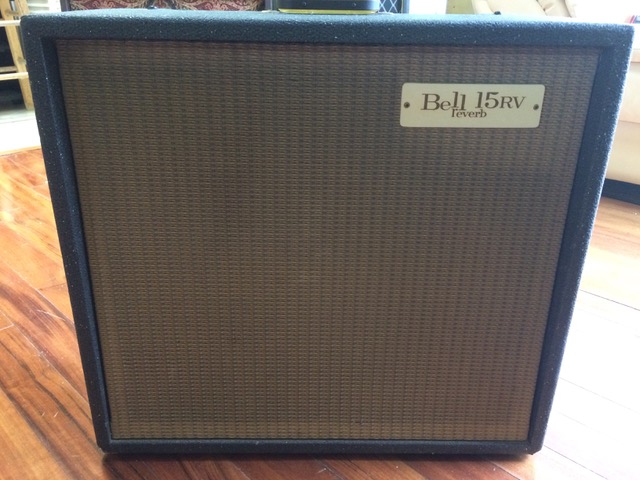 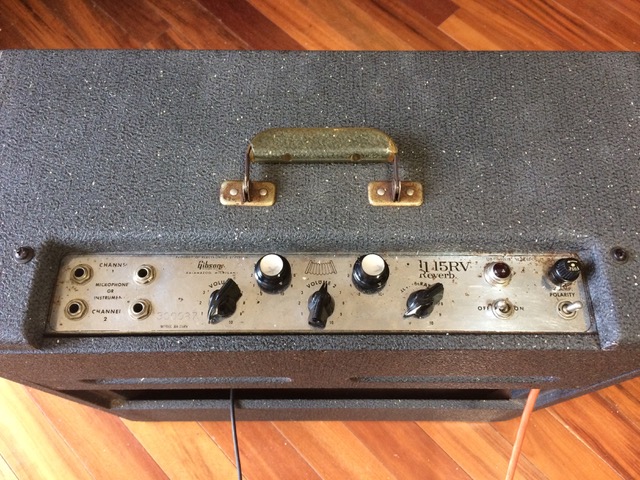 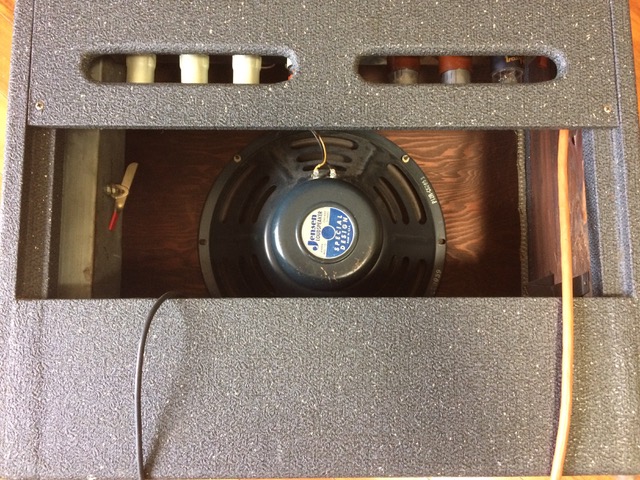 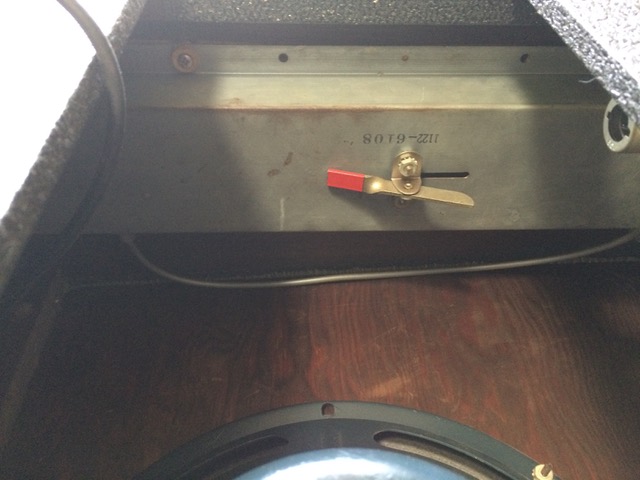 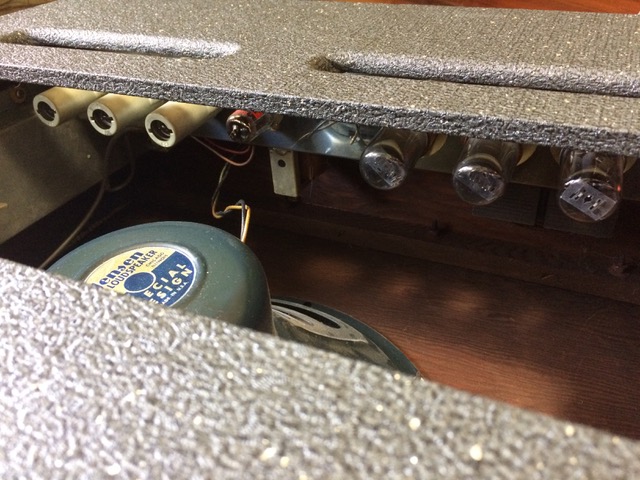
Rate the BA-15RV...
|
 |
Atlas IV (Power Plus)
|
|
1x15" Guitar Combo
Speakers: 15"
Inputs: 2
Channels: 1
Volume Controls: 1
Tone Controls on Each Channel: Bass, treble
Tremolo: No
Reverb: No
Tubes: 5 (2x6EU7, 6C4, 2x6L6 (correspond to Epiphone EA-71/72 Constellation))
Diodes: 5 (3)
Watts Output:
Shipping Totals: 1963: 167, 1964: 860, 1965: 271, 1966: 428, 1967: 186 (new style from 1966)
Schematic
Rate the Atlas IV (Power Plus)...
|
 |
Atlas IV L (Power Plus)
|
|
1x15"? Guitar Combo
Speakers: 1x15"?
Inputs: 2?
Channels: 1?
Volume Controls: 1?
Tone Controls on Each Channel: Bass, treble?
Tremolo: No?
Reverb: No
Tubes: 5 (Pre (2x6EU7, 1x6C4), Pow (1x6L6 PAIR) (correspond to Epiphone EA-71/72
Constellation))?
Diodes: 5 (3)?
Watts Output:
Shipping Totals: 1967: 37 (new style)
Rate the Atlas IV L (Power Plus)...
|
 |
Atlas Medalist
|
|
1x15" Guitar Combo
Speakers: 1x15"
Inputs: 2
Channels: 1
Volume Controls: 1
Tone Controls on Each Channel: Bass, treble
Tremolo: No
Reverb: No
Tubes: 5 (Pre (2x6EU7, 1x6C4), Pow (1x6L6 PAIR) (correspond to Epiphone EA-71/72 Constellation))
Diodes: 3
Watts Output:
Shipping Totals: 1964: 297, 1965: 491, 1966: 385, 1967: 155 (new style from 1965)
Schematic
Combo variety of the Power Plus amp.
played one all thru high school....had to remove the chassis from the cabinet and build a head out of; too much vibration for the tubes....meant to be a bass amp, but i used it for guitar with a 16 ohm radio shack 15"...it's odd that this amp has a 16 ohm speaker out only....sounded cool....everything on 11
?ez das unt goot amplifier?
!yah das ez unt goot amplifier! (Mark)
I've played on an Atlas Medalist. This amp sounds like a cranked Marshall when pushed. Just turn everything up to 10 and it's rock bliss. It has an awesome midrangey grind like a Marshall, but is warm at the same time... bluesey and fuzzy, yet focused. These amps are not to be shunned. They are serious sleepers. (Brad, Mar 2014)
Rate the Atlas Medalist...
|
 |
Mercury I (Power Plus)
|
|
2x12" Guitar Combo
Speakers: 2x12"
Inputs: 2+2
Channels: 2
Volume Controls: 2
Tone Controls on Each Channel: Bass, middle, treble
Tremolo: Depth, frequency
Reverb: No
Tubes: 7 (8) (6EU7 (splitter), 6FQ7 (driver), 2x6L6 (output) or 2x6EU7, 6C4 and 1/2 6EU7 (tremolo), 1/2 6EU7 (splitter), 6FQ7 (driver), 2x6L6 (output), 0A2)
Diodes: 5 (3)
Watts Output:
Shipping Totals: 1963: 118, 1964: 408, 1965: 115, 1966: 2
Schematic
Sweet sounding as they come. I have owned a 1961 Bandmaster, 1964 princeton, Carvin XB-100 and other assorted amps and this is the sweetest sounding amp. Two 12" Jensen speakers sing! Gibson amps are way underrated. Get them while they are still cheap. (Bobcous)
Rate the Mercury I (Power Plus)...
|
 |
Mercury II (Power Plus)
|
|
1x15 and 1x10" Guitar Combo
Speakers: 1x15" & 1x10"
Inputs: 2+2
Channels: 2
Volume Controls: 2
Tone Controls on Each Channel: Bass, middle, treble
Tremolo: Depth, frequency
Reverb: No
Tubes: 7 (8) (6EU7 (splitter), 6FQ7 (driver), 2x6L6 (output) or 2x6EU7, 6C4 and 1/2 6EU7 (tremolo), 1/2 6EU7 (splitter), 6FQ7 (driver), 2x6L6 (output), 0A2)
Diodes: 5 (3)
Watts Output:
Shipping Totals: 1963: 55, 1964: 365, 1965: 93, 1966: 150, 1967: 40 (new style from 1966)
Schematic
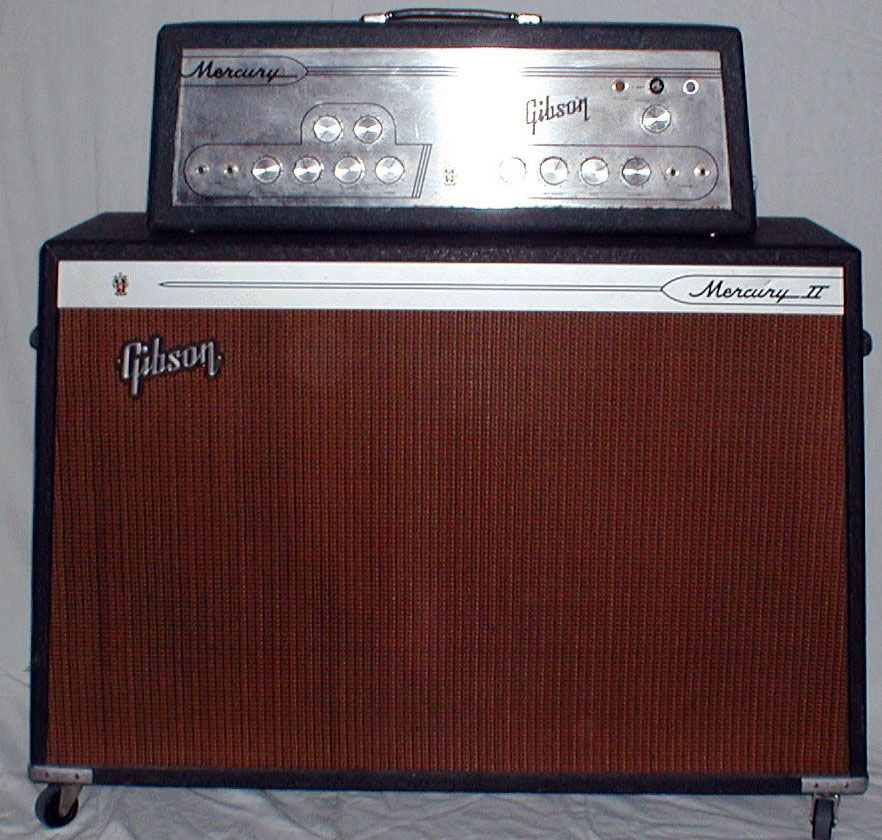
Rate the Mercury II (Power Plus)...
|
 |
Mercury II L (Power Plus)
|
|
1x15? and 1x10"? Guitar Combo
Speakers: 15" & 10"? (JBL?)
Inputs: 2+2?
Channels: 2?
Volume Controls: 2?
Tone Controls on Each Channel: Bass, middle, treble?
Tremolo: Depth, frequency?
Reverb: No
Tubes: 7 (8) (6EU7 (splitter), 6FQ7 (driver), 2x6L6 (output) or 2x6EU7, 6C4 and 1/2 6EU7 (tremolo), 1/2 6EU7 (splitter), 6FQ7 (driver), 2x6L6 (output), 0A2?
Diodes: 5 (3)?
Watts Output:
Shipping Totals: 1967: 6 (new style)
Rate the Mercury II L (Power Plus)...
|
 |
Mercury Medalist
|
|
1x15 and 1x10" Guitar Combo
Speakers: 15" & 10"
Inputs: 2+2
Channels: 2
Volume Controls: 2
Tone Controls on Each Channel: Bass, middle, treble
Tremolo: Depth, frequency
Reverb: No
Tubes: 8 (2x6EU7, 6C4 and 1/2 6EU7 (tremolo), 1/2 6EU7 (splitter), 6FQ7 (driver), 2x6L6 (output), 0A2)
Diodes: 3
Watts Output:
Shipping Totals: 1964: 155, 1965: 168, 1966: 3, 1967: 1 (new style from 1965)
Schematic
Combo variety of the Power Plus amp.
Versions with two and four 6L6 tubes.
Rate the Mercury Medalist...
|
 |
Titan I (Power Plus)
|
|
2x12" Guitar Combo with Tremolo
Speakers: 2x12"
Inputs: 2+2
Channels: 2
Volume Controls: 2
Tone Controls on Each Channel: Bass, middle, treble
Tremolo: Depth, frequency
Reverb: No
Tubes: 11 (3x6EU7, 2x12AU7 (splitter), 6FQ7 (driver), 4x6L6 (power), 0A2 (correspond to Epiphone EA-500T))
Diodes: 3
Watts Output:
Shipping Totals: 1963: 29, 1964: 172, 1965: 52, 1967: 2
Schematic Titan I, III, V
The Titan I, III, & V all used the same head. It was rated at 65 watts. Reviews usually found under 'bass amps" (reason unknown) on Harmony Central, but only the V was really considered for lead and bass. (Tom Kaemmerling)
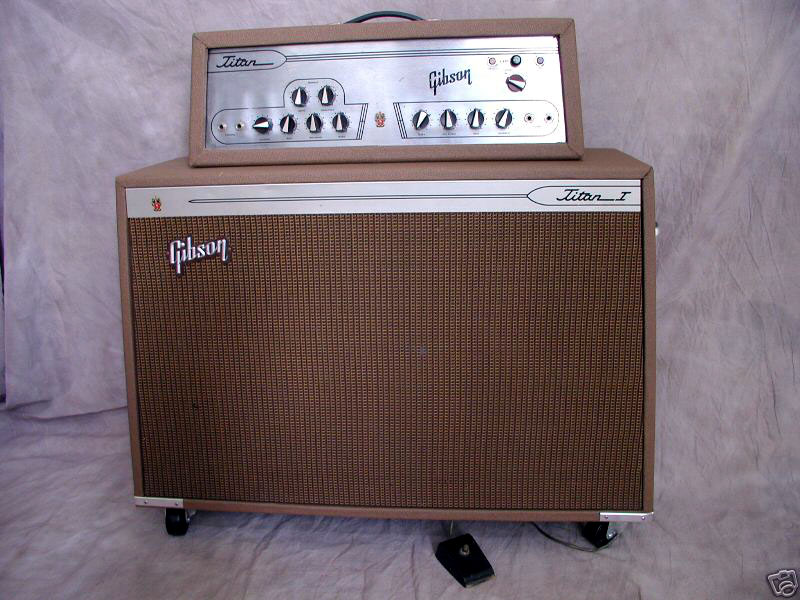 
Rate the Titan I (Power Plus)...
|
 |
Titan III (Power Plus)
|
|
1x15" and 2x10" Guitar Combo with Tremolo
Speakers: 1x15" & 2x10"
Inputs: 2+2
Channels: 2
Volume Controls: 2
Tone Controls on Each Channel: Bass, middle, treble
Tremolo: Depth, frequency
Reverb: No
Tubes: 11 (3x6EU7, 2x12AU7 (splitter), 6FQ7 (driver), 4x6L6 (power), 0A2 (correspond to Epiphone EA-500T))
Diodes: 3
Watts Output: 65
Shipping Totals: 1963: 24, 1964: 189, 1965: 67, 1966: 95, 1967: 24 (new style from 1966)
Harmony Central Review Titan III
Harmony Central Review Titan III Combo
Schematic Titan I, III, V
I have a 1964 Titan III. That's a piggy back with a ported 15" CTS speaker with a passive cross-over to two 10" concert series Jensens. The ballast resistor for the '15" only' switch selection is not original, but was on the speaker cab when I purchased it. This amp has a tone you would not believe... I mean rich. What a smooth, mellow sound. If you want loud, look somewhere else... way to much headroom in the push-pull 6L6's. LDR driven tremelo is rich, but weak. Remove the wheels, and the cab tilts back on a bar that extends from the back of the cab. The head locks onto the top of the cab, but the tubes rattle with the vibrations if you play at any volume, so I set it on a chair to vent. You can fry eggs on the head after it's on an hour or so. (Tom Kaemmerling)
The Titan I, III, & V all used the same head. It was rated at 65 watts. Reviews usually found under 'bass amps" (reason unknown) on Harmony Central, but only the V was really considered for lead and bass. The III, in fact, uses two sealed-back Jensen Special Design mid-range speakers with a passive cross-over to either an Altec or CTS 15" serving the lower frequencies. The III was definitely for lead and/or rhythm. (Tom Kaemmerling)
For a really detailed review, see www.listphile.com/Vintage_Guitars_Amps_and_gear/1964_Gibson_Titan_III (Tom Kaemmerling)
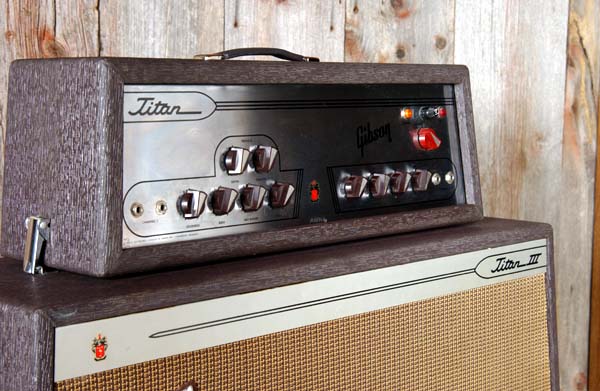 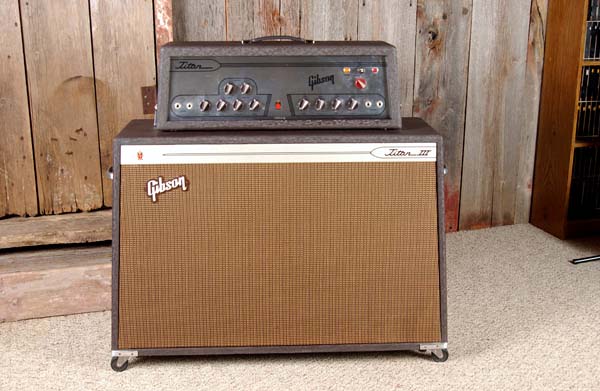 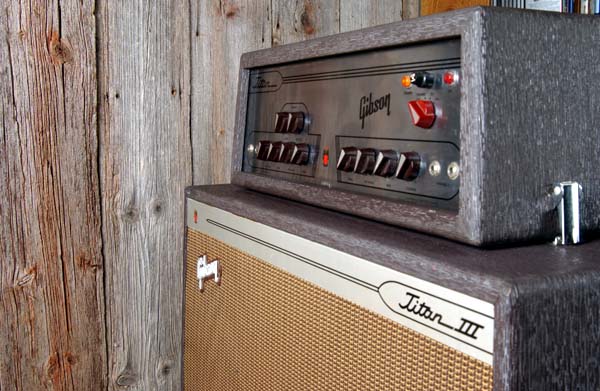 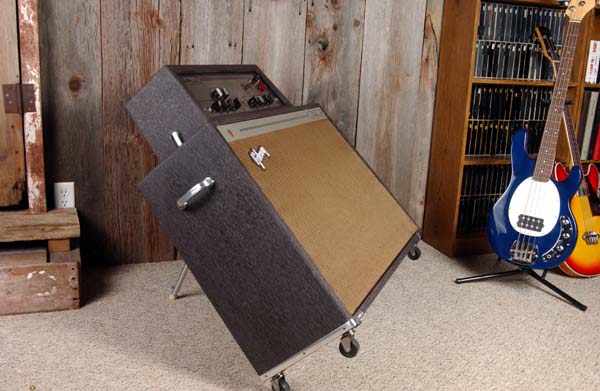 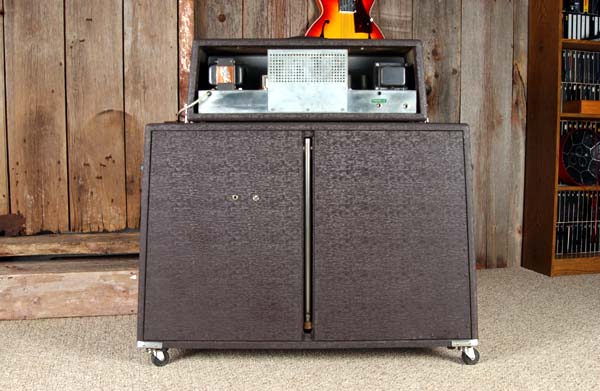 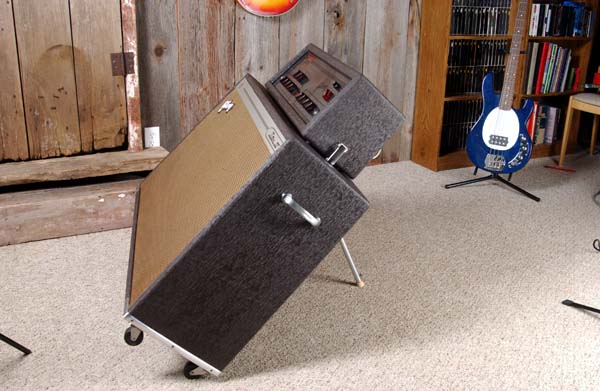 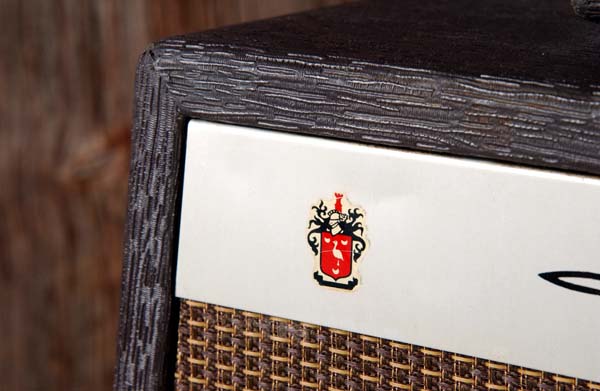 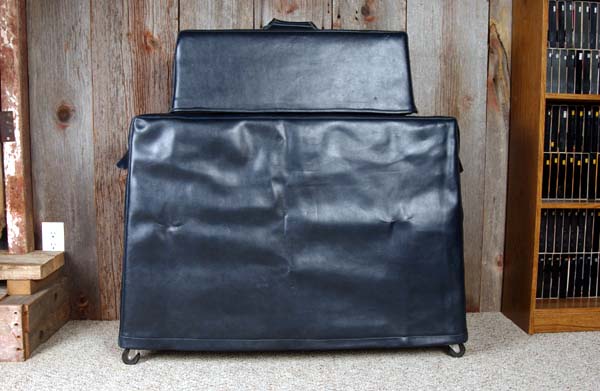 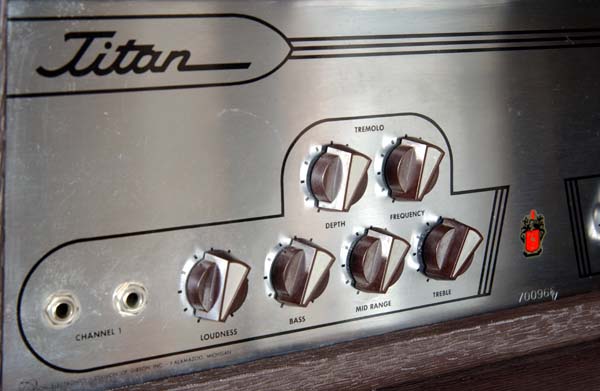 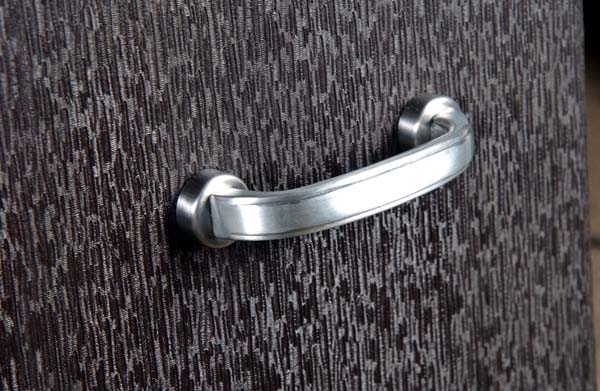 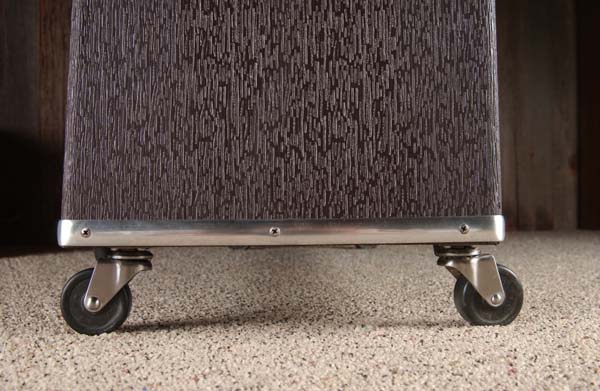 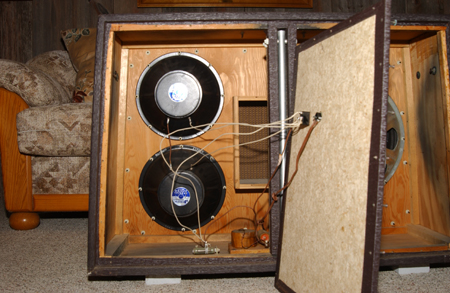 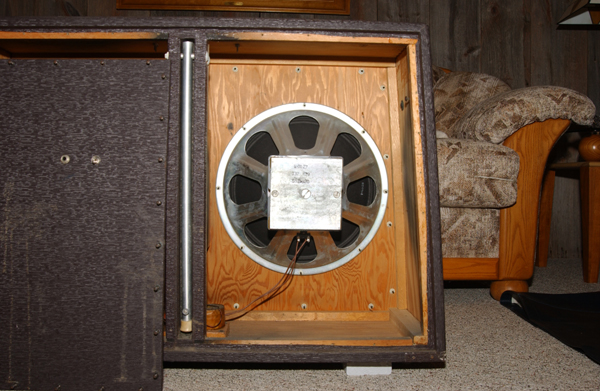 
Rate the Titan III (Power Plus)...
|
 |
Titan V (Power Plus)
|
|
2x15" Guitar Combo with Tremolo
Speakers: 2x15" JBL
Inputs: 2+2
Channels: 2
Volume Controls: 2
Tone Controls on Each Channel: Bass, middle, treble
Tremolo: Depth, frequency
Reverb: No
Tubes: 11 (3x6EU7, 2x12AU7 (splitter), 6FQ7 (driver), 4x6L6 (power), 0A2 (correspond to Epiphone EA-500T))
Diodes: 3
Watts Output:
Shipping Totals: 1963: 27, 1964: 43, 1965: 42, 1966: 52, 1967: 27 (new style from 1966)
Schematic Titan I, III, V
Schematic
The Titan I, III, & V all used the same head. It was rated at 65 watts. Reviews usually found under 'bass amps" (reason unknown) on Harmony Central, but only the V was really considered for lead and bass. (Tom Kaemmerling)
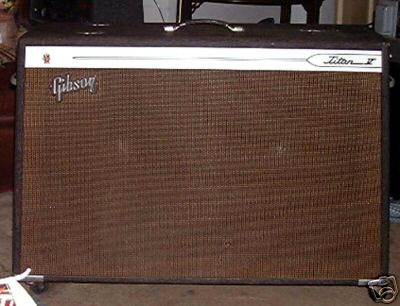   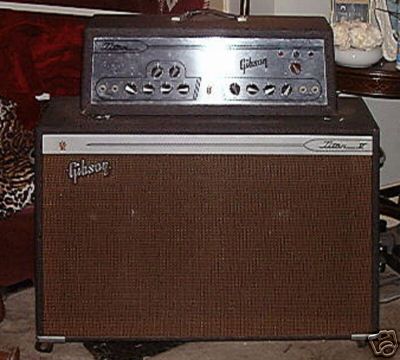
Rate the Titan V (Power Plus)...
|
 |
Titan Medalist
|
|
1x15" and 1x10" Guitar Combo with Tremolo
Speakers: 1x15" & 1x10"
Inputs: 2+2
Channels: 2
Volume Controls: 2
Tone Controls on Each Channel: Bass, middle, treble
Tremolo: Depth, frequency
Reverb: No
Tubes: 11 (3x6EU7, 2x12AU7 (splitter), 6FQ7 (driver), 4x6L6 (power), 0A2 (correspond to Epiphone EA-500T))
Diodes: 3
Watts Output:
Shipping Totals: 1964: 66, 1965: 51, 1966: 25, 1967: 6 (new style from 1965)
Schematic with four 6L6s
I found and bought one a few years back. [...] it seems to be quite rare.
Very clean, but with tube color, until loud as stock. The odd tube selection lends lots of headroom. The odd speaker arangement gives crystal clear jazz sounds. Tremelo is unique. Very lush, but depth varies by volume as well as knob setting. Low volumes get little with it cranked, but loud playing needs just a touch. The 2 channels seem to be "inverted", so some cool cross phasing effects can be had by chaining them together. Overall, a very LOUD amp with gobs of headroom, and just a bit of bluusy crunch at the top, undriven. Sounds best with peaky humbuckers, but brings out most guitars well. Truly a gem. Mine was a barn find, so condition is not perfect. (John, Dec 2017)
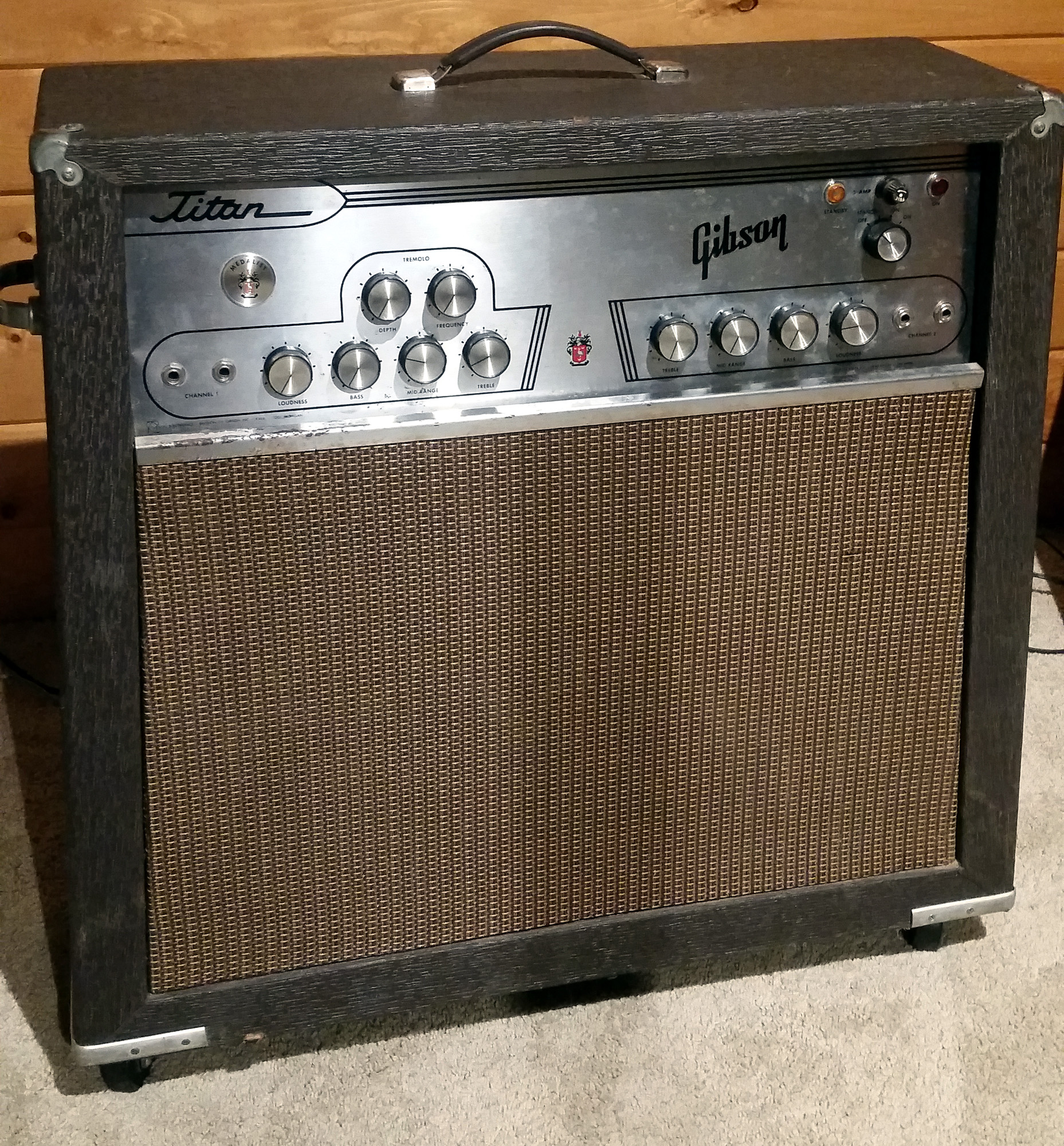 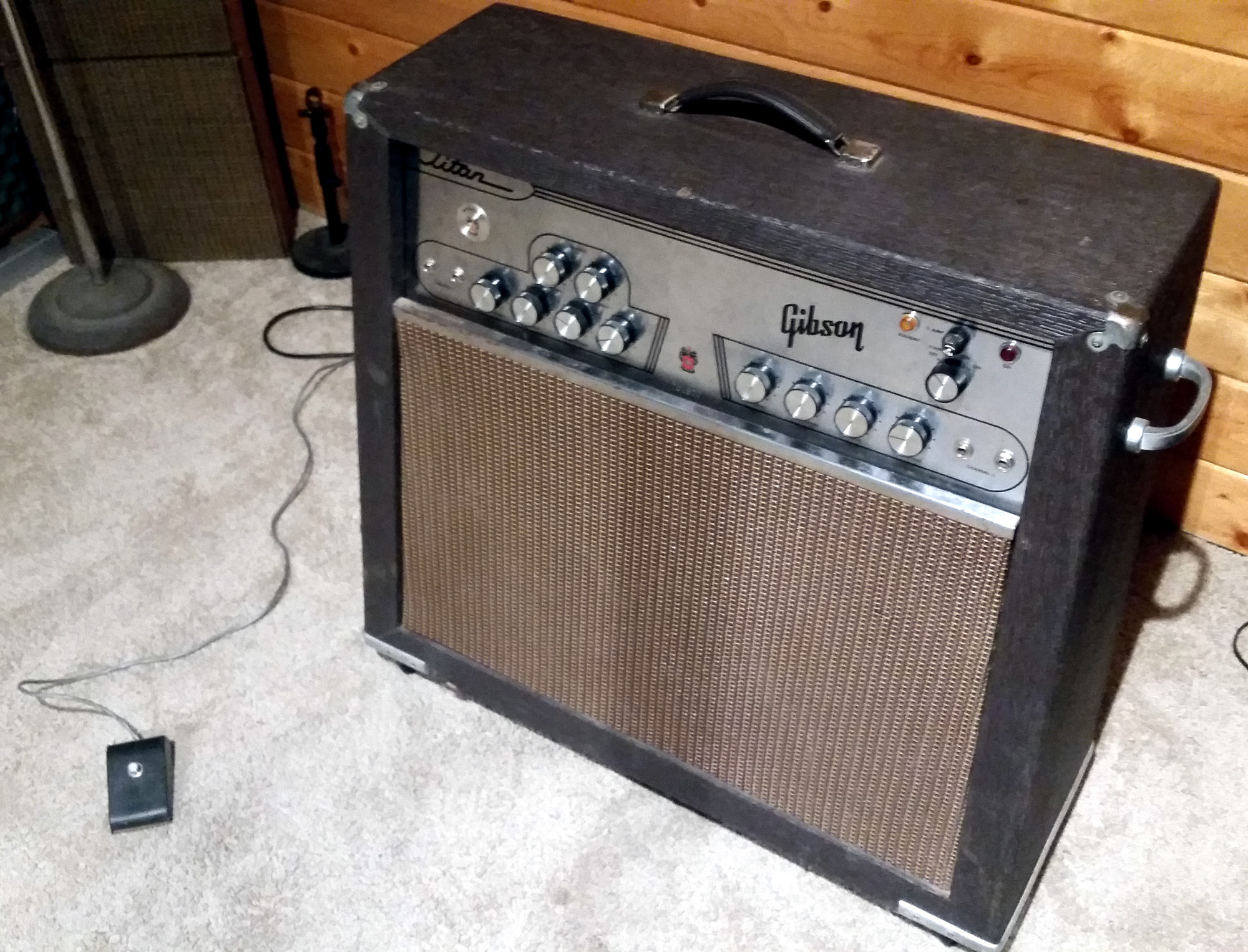 
Rate the Titan Medalist...
|
 |
Thor
|
|
50W 2x10" Bass Combo
Speakers: Vertical 2x10", Usually 50-watt 8-ohm Jensen C10N wired in series for 16 ohm total impedance
Inputs: 2 (active as well as passive bass input)
Channels: 1?
Volume Controls: 1
Tone Controls on Each Channel: Individual Treble and Bass Controls, with separate knob for power and polarity
Tremolo: No
Reverb: No
Tubes: 1x6EU7 preamp, 1x6EU7 phase inverter, 2xEL34/6CA7 power tubes
Diodes: 3
Watts Output: 50
Extension Speaker Jack: Not on schematic, although seen in some chassis photos
Shipping Totals:
Harmony Central Review Thor 210 Bass Combo
bgra.net Review
Schematic
Introduced in 1968?
[...] With it [a 'a Decca [bass] with a custom red, white and blue LATEX
paint job. Sort of a flag motif with red and white stripes on the body
and even a peace sign'] I got a Gibson Thor amp. An all
in one unit with two 12" speakers. Very under powered, no distortion
or blowing of speakers even when turned all the way up. (Karl Smelker, 'First bass, where is it now and butchering', The Bottom Line, Thursday, December 11, 1997, Volume 1997: Number 477; pirated without permission)
I need input regarding the old Gibson Thor bass amp. One, or perhaps
two -- I can't remember -- has shown up in a local pawn shop. I seem to
remember the first one as being a tube combo amp with 2x10" speakers in
a open back. The one that's there now is solid-state with a closed
back.
I don't know if I'm more amazed that two different Thor amps showed up
in the same shop within a year, or that any at all did; but I need a
savvy Gibson amp historian to give me a heads up on these. Are they any
good.
I would want them only for low to moderate volume applications,
primarily for URB. I find their size and weight appealing, but don't
know enough about the model to have any insights regarding sound and
quality. Anybody know? Anybody know the history of these amps -- how
long they were in production and any major changes in spec?
FWIW, the one presently in the shop carries a sticker price of $200. (Harry Nuttall, 'Thor: Thud of Thunder', The Bottom Line, Friday, March 5, 1999, Volume 1999: Number 077; pirated without permission)
The Kalamazoo Bass 50 is electronically identical to the Gibson Thor Bass amp. [...] Not only that, both these amps came with the same 2x10 Jensen C10N speaker set. Wired in series for a 16-ohm total impedance. They mainly differed in the cabinet construction. See my detailed description of the upgrade project on the 'Telecaster Discussion Page Re-Issued' (TDPRI). Here's the link with photos and both schematics. (Geno)
It's been years (30) that my brother used it ( played a Gibson SG bass - he was only 11 y.o.) when we garage banded back in the early 70's but I still have that thing though it is collecting dust in storage. When we used it, it sounded quite beefy for such a small luggable amp. It was a perfect club amp that didn't break the bank or your back. It's simple tube construction made it easy to repair (though it never needed it except for the vol. pot.). Having a tall body made it easier than other bass amps to lug around in back of cars or trucks. For it's investment back then I'd say that we got a good deal. (Mark, 2011)

Rate the Thor...
|
Previous
Top | Main | Amps | Links | Other Stuff
Gibson Garage, Copyright © 2003-20 Dace. This is no official Gibson site, and I am not affiliated with the company in any way. Disclaimer.
|
















_front_2000x1500.jpg)
_back_2000x1500.jpg)
















